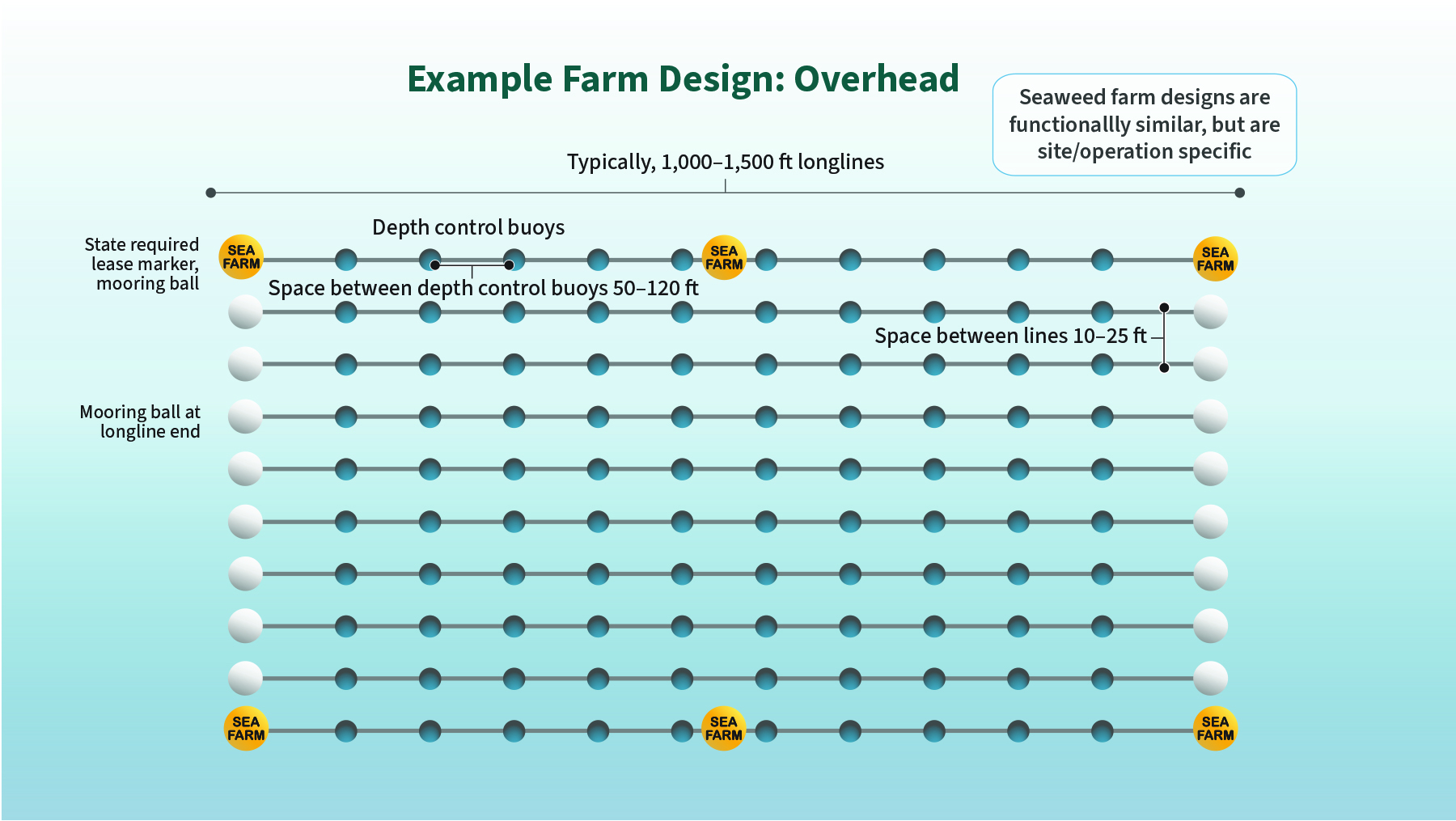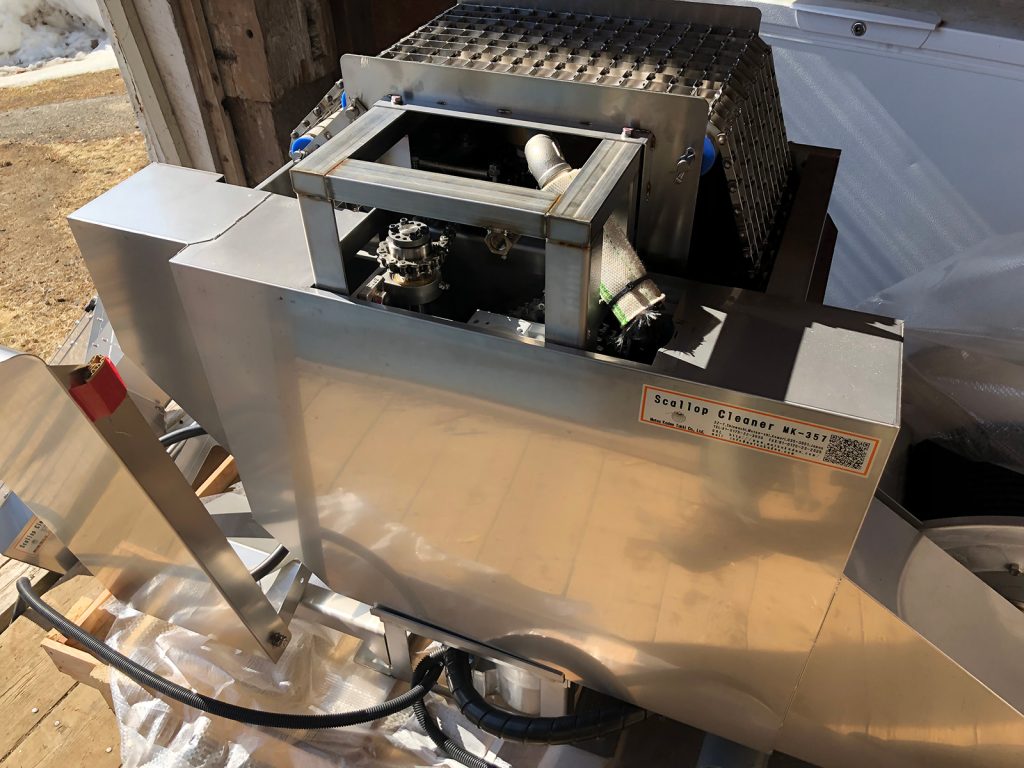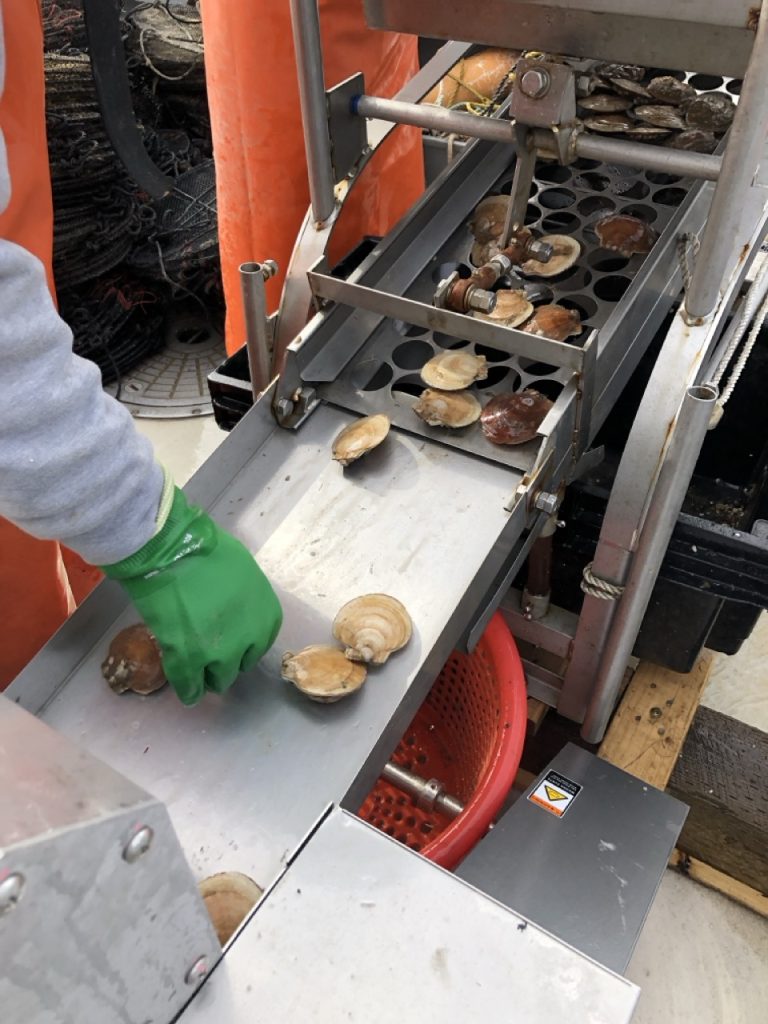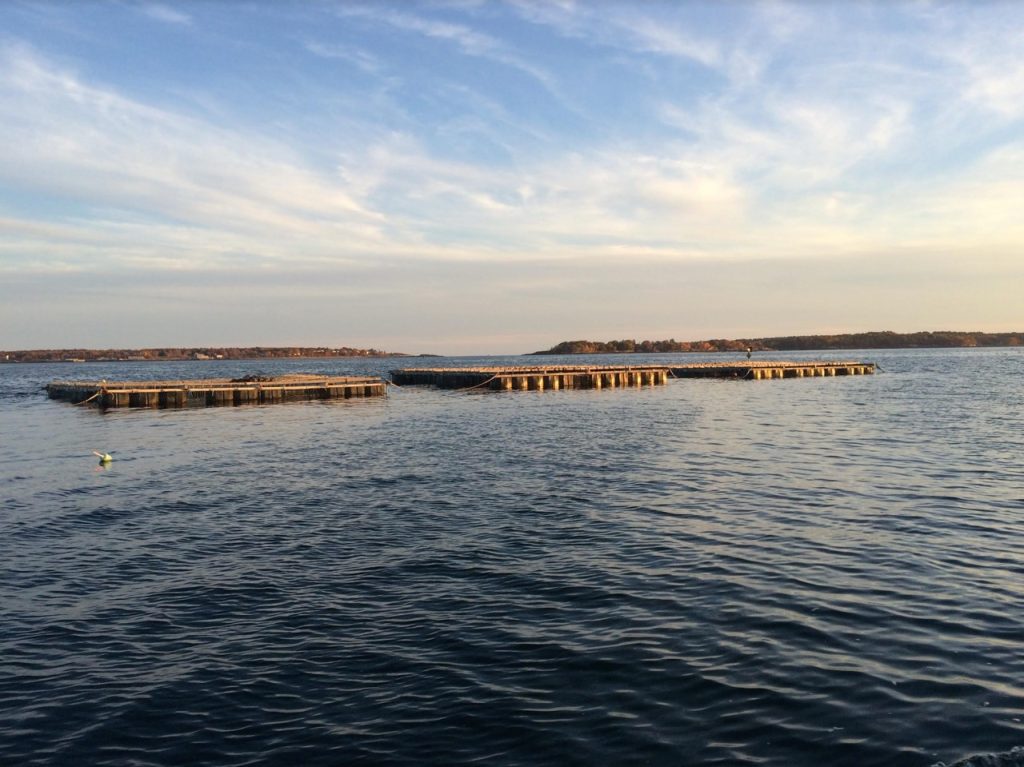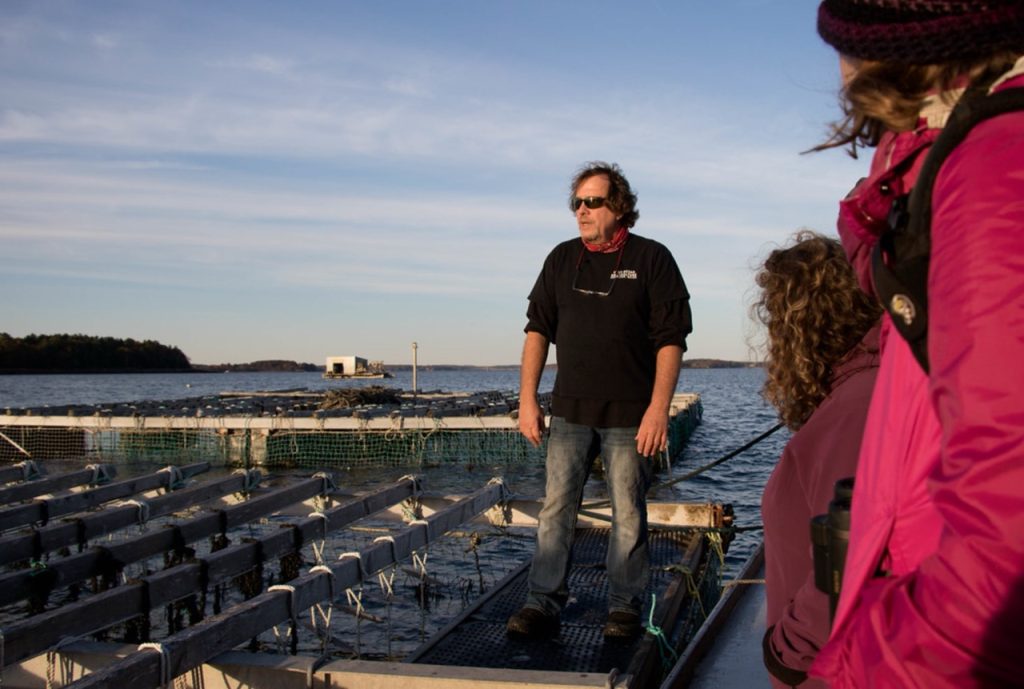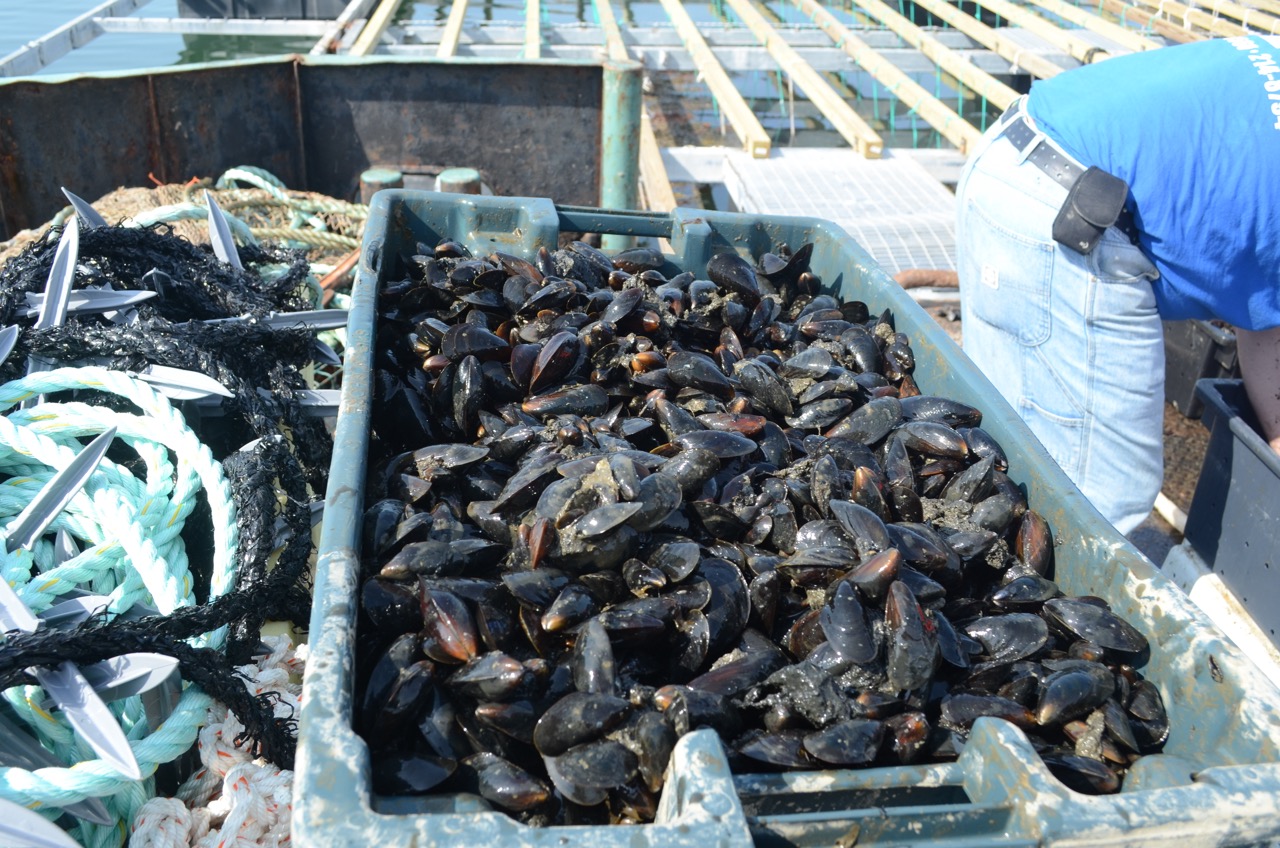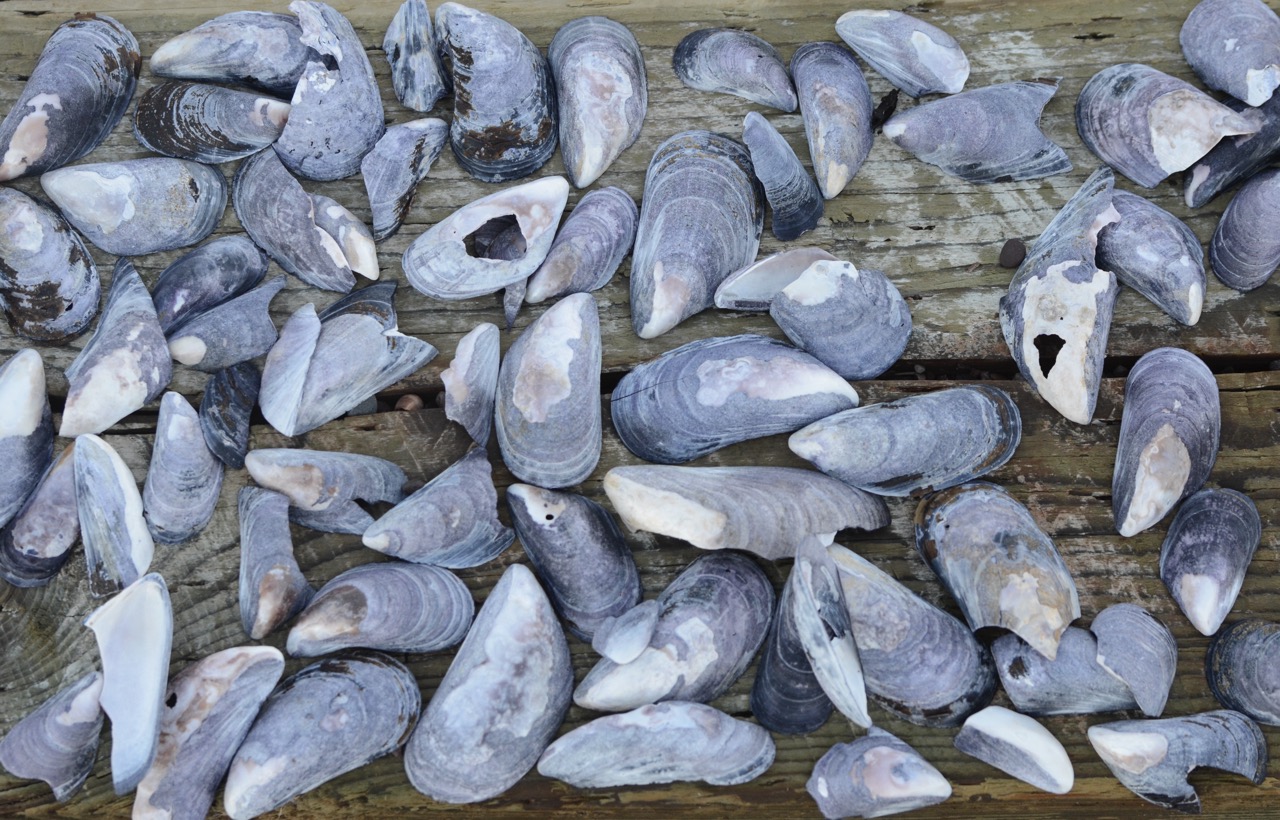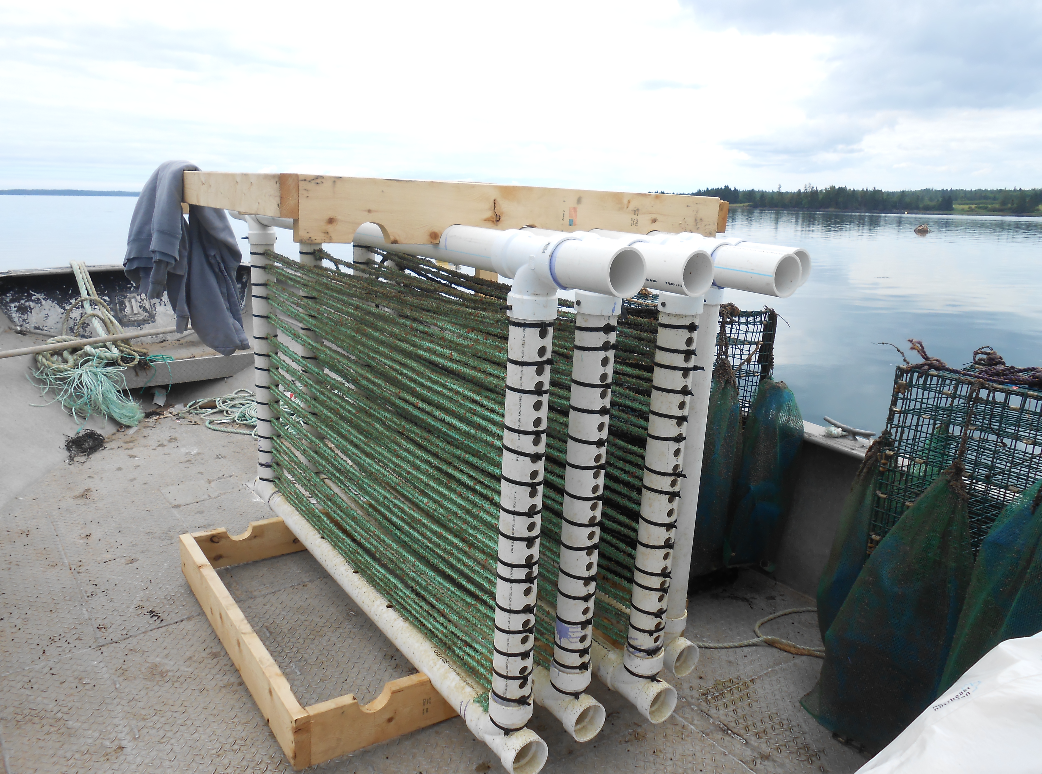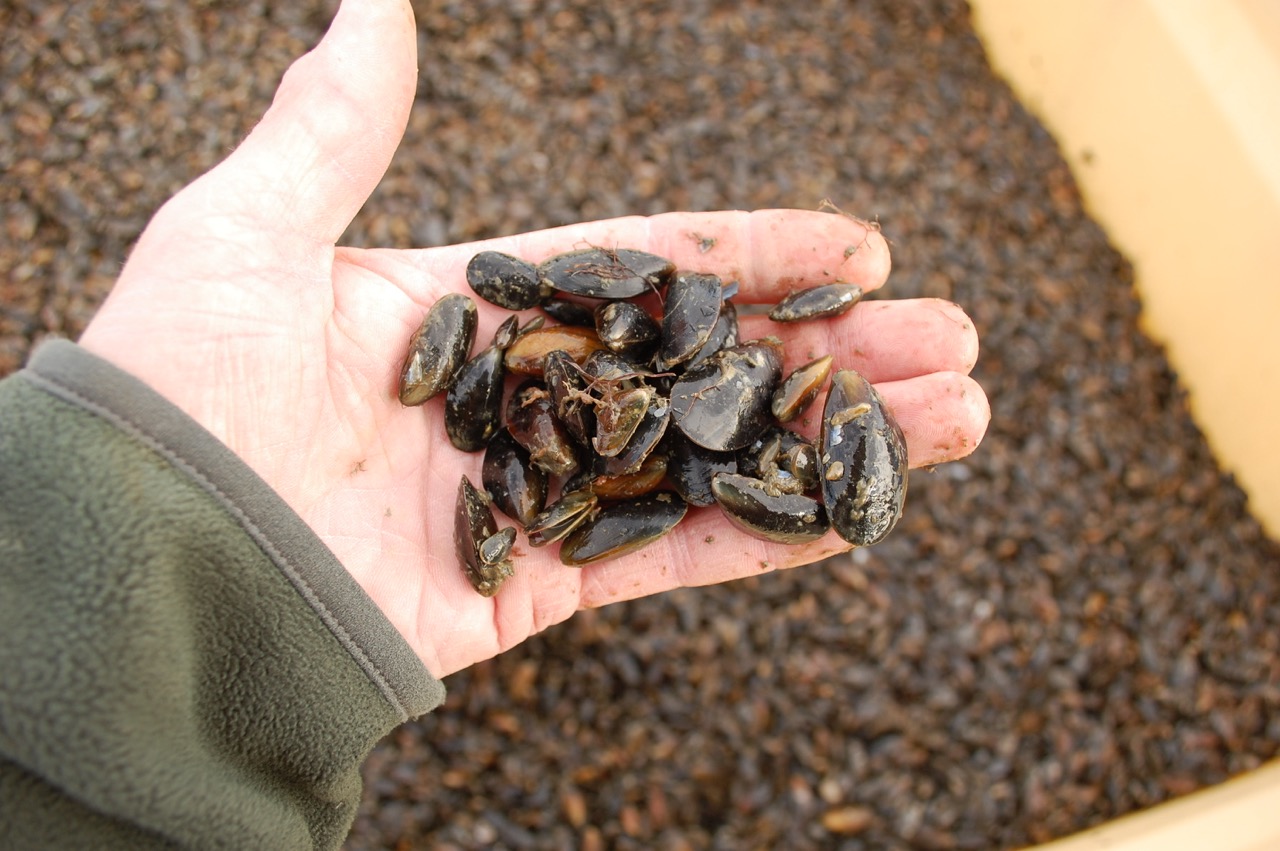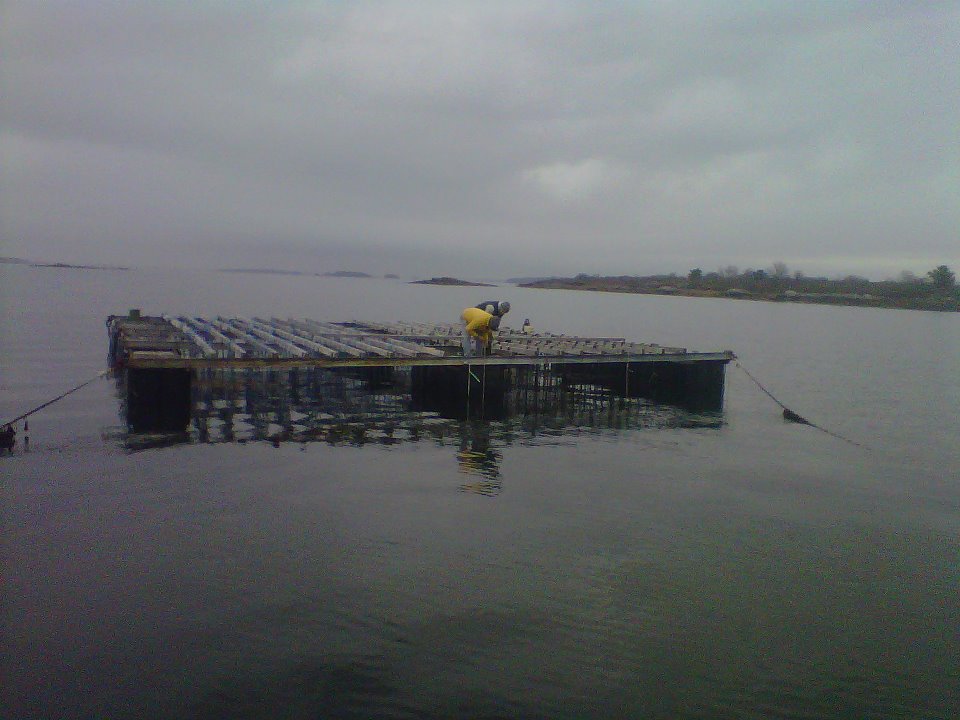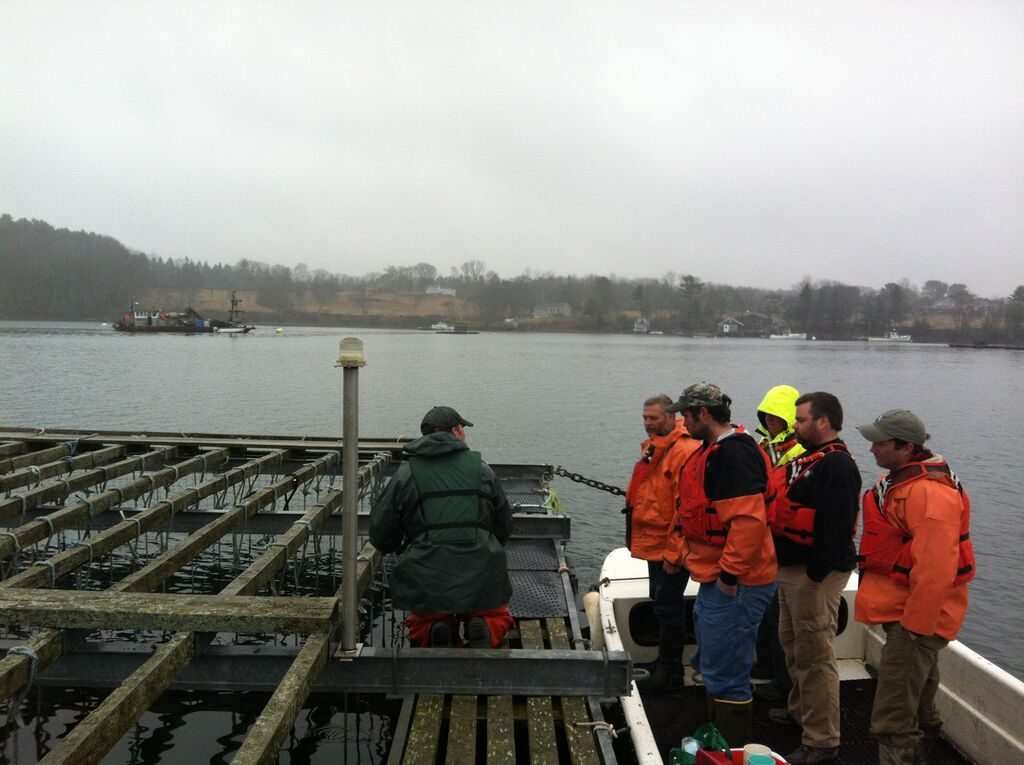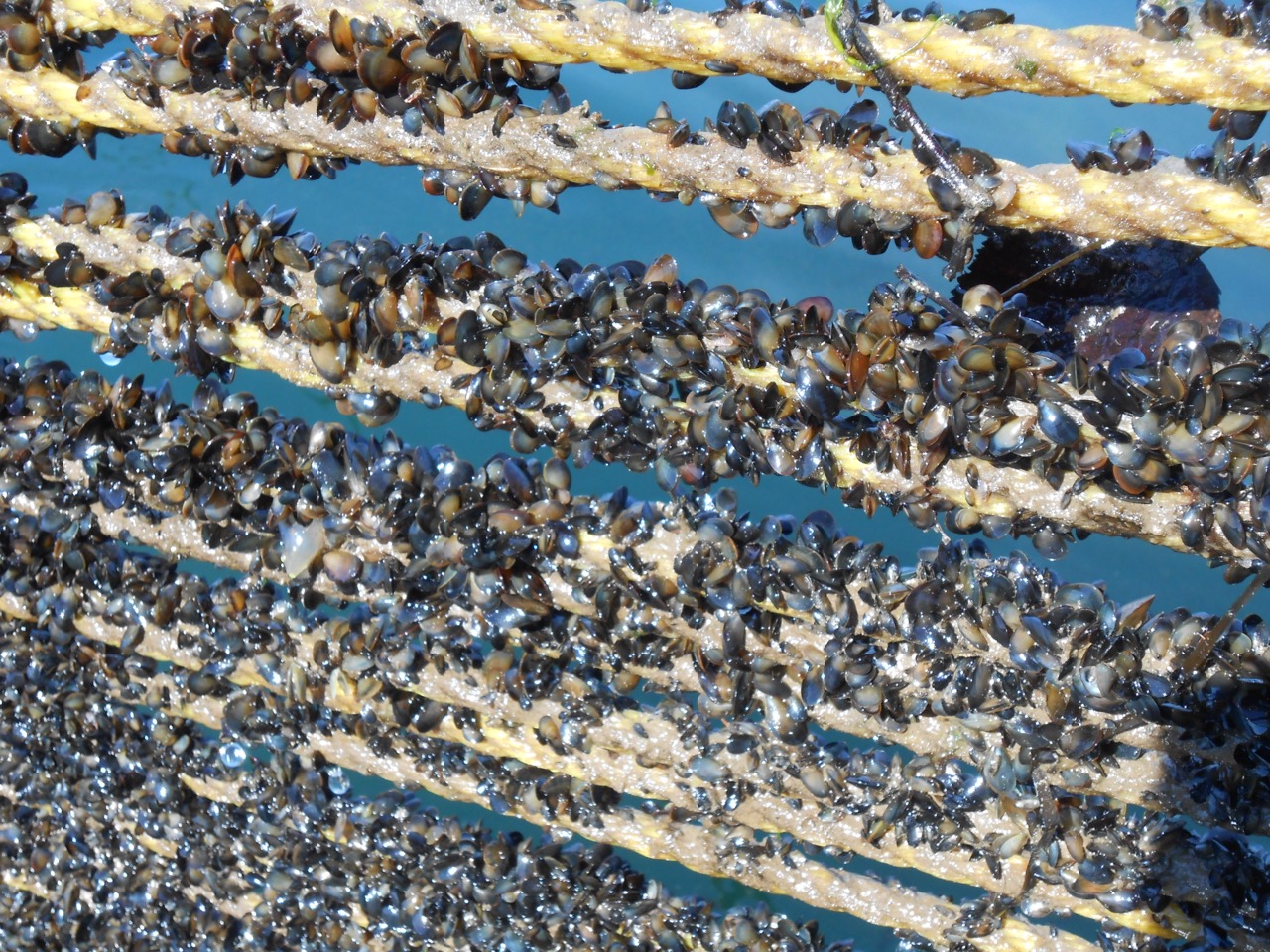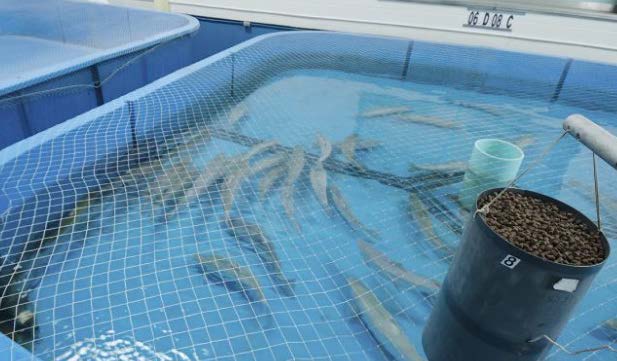What’s in the Water?
Kelp Farming
Click to download What’s in the Water—Kelp Farming fact sheet
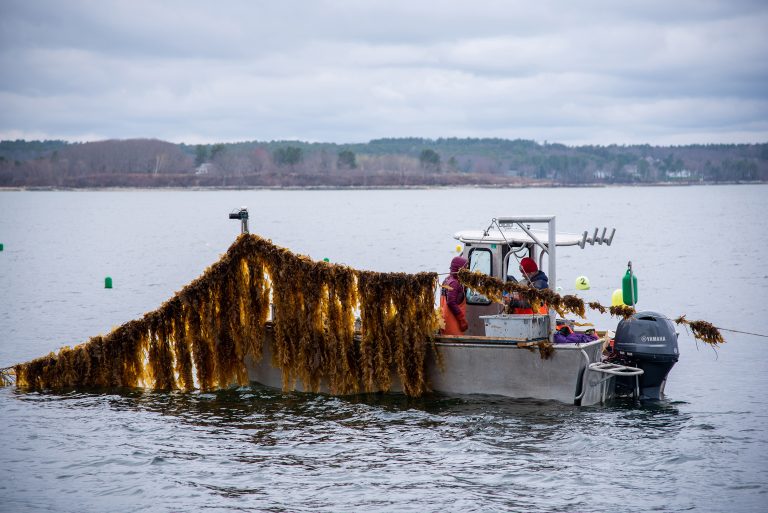
Kelp farming is a growing industry in Maine, with more than 40 active farms across the state. Seaweeds, including kelp, have been harvested for thousands of years by indigenous communities for sustenance. Today, kelp is commercially farmed and harvested for foods and food products. It is also used in cosmetics, animal feed, organic fertilizers, and more.
What Can Be Seen?
From the shore, you’ll only be able to see the surface of the kelp farm. You may be able to see rows of buoys spaced anywhere from 10 to 25 feet apart, and mooring balls at the corners of the site labeled “Sea Farm” that contain site information. However, seeing a kelp farm is dependent on the season—kelp is farmed in the winter and harvested in the spring, and most farms remove the majority of their gear (except the corner site markers) after the harvest.
Beneath the surface are horizontal ropes called longlines on which the kelp is planted. A longline runs the length of the row of buoys, anywhere between 1,000-1,500 feet, and is typically suspended 6 to 8 feet below the surface to keep the kelp submerged. Longlines may be differentiated by color buoys — this helps farmers visualize their underwater farm structure and identify tangled or broken lines. The ends of the longlines are connected to a mooring chain, and the mooring chain is anchored to the sea floor. If you were to dive below the farm at the end of the season in spring, you would see curtains of kelp on the longlines!
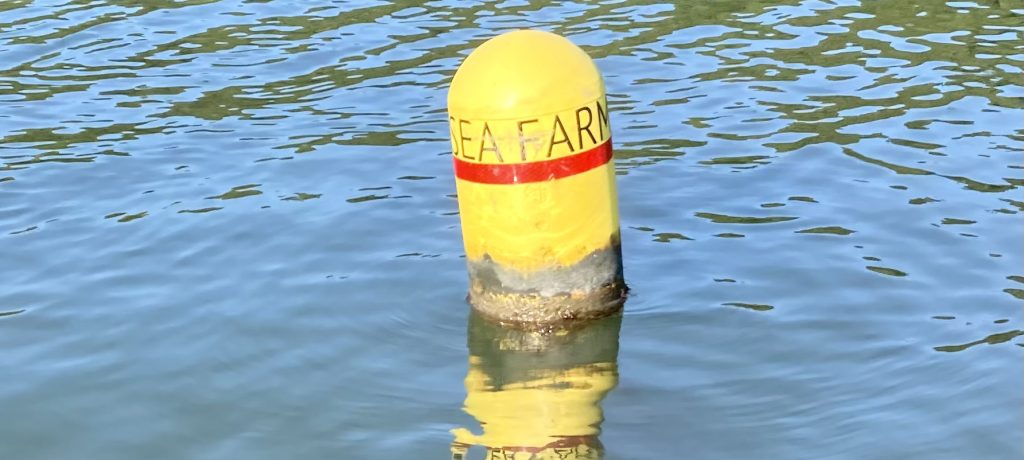
What Can’t Be Seen?
Beneath the surface are horizontal ropes called longlines on which the kelp is planted. A longline runs the length of the row of buoys, anywhere between 1,000-1,500 feet, and is typically suspended 6 to 8 feet below the surface to keep the kelp submerged. Longlines may be differentiated by color buoys—this helps farmers visualize their underwater farm structure and identify tangled or broken lines. The ends of the longlines are connected to a mooring chain, and the mooring chain is anchored to the sea floor. If you were to dive below the farm at the end of the season in spring, you would see curtains of kelp on the longlines!
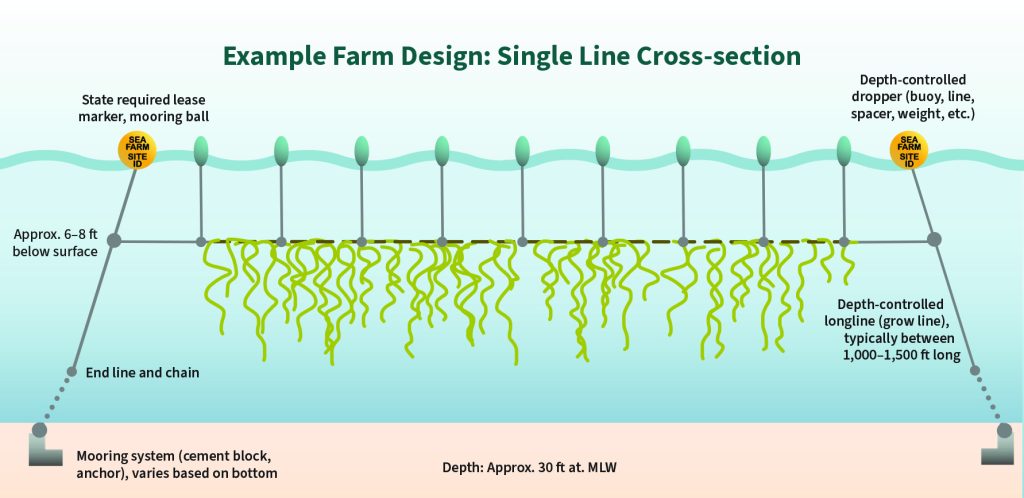
Farming Process
- Nurseries (September – November, fall)
- All seaweed farming begins with spores (called ‘seed’). For kelp, seed production starts on land in a nursery facility. Kelp seeds are introduced into sea water-filled tanks; PVC pipes wrapped in twine (called ‘kelp spools’) are set on the bottom. The seed attaches to the twine and grows. When the spool becomes brown and fuzzy with the growing kelp, the farmers know the seed is ready.
- Sea Farms (November – May, fall – spring)
- Once the ocean waters begin to cool, typically between November and December, the seeded twine is unspooled around the longlines on the farm sites, where the kelp’s natural attachment structure — the holdfast — begins to grow onto the stronger longline, anchoring the kelp to the farm structure for the duration of the winter growing season.
- Harvest (April – June, spring)
- By spring, the kelp will have grown from tiny seedlings the size of a grain of sand into long, narrow blades, which can be upwards of 10 feet long. To harvest the kelp, farmers lift the longlines out of the water and hand-cut the kelp off the lines and into containers on the deck of their boats. Once a boat is filled and the harvest day is over, farmers bring their kelp to shore where it is sold to processors (that are contracted in advance) who are responsible for making kelp products that people around the world know and love.
Why Kelp Aquaculture?
Seaweed is a climate-friendly crop, requiring no freshwater, fertilizer, or land to grow in the ocean. It absorbs carbon dioxide, nitrogen, and phosphorus; releases oxygen into water, mitigating the risk of harmful algal blooms; it also has the potential to buffer
the effects of ocean acidification in its surrounding environments.
Many cultures have incorporated seaweed into their diets and wellness practices for thousands of years, and US consumers are only beginning to recognize its significant health benefits and nutritional value. As the demand for kelp increases, kelp farming can supplement wild harvest to increase the reach and impact of seaweed products.
Kelp farming supports fishermen and others with year-round work opportunities. Many of Maine’s fisheries are seasonal; because kelp is farmed in the winter, it can provide supplemental income to lobstermen and fishermen during their off-season.
Frequently Asked Questions about KELP
Why are Maine waters suitable for kelp farming?
Maine waters contain a great amount of nutrients, are in the right temperature zone, and have a diversity of environments along the coast that are provide protection for culture.
Why does Maine lead the United States in kelp production?
According to the National Seaweed Hub, kelp requires cold, clean, salty waters to thrive – characteristics that make Maine appealing to seaweed farmers.
Wild kelp beds support a diversity of life, including a variety of fish and invertebrates. Will kelp farms in Maine attract new biodiversity on farm sites?
Researchers at the University of New England used visual and environmental DNA methods to see if kelp farms increased biodiversity and provided new habitat, but found minimal difference between sites with and without kelp farms. This is promising, as it demonstrates that kelp farms don’t impact or disturb the natural biodiversity in an area.
How do kelp farms affect the environment?
Kelp farms provide a variety of benefits to their surrounding waters. As it grows, kelp has the potential to improve local water quality, increase oxygen levels in water, and defend against ocean acidification. By naturally regulating carbon dioxide and nutrients in the water, seaweed farms can support healthy shellfish populations, which are particularly susceptible to high levels of carbon dioxide and the harmful effects of excess nutrients.
Where are kelp farms located?
Kelp farms are located in state waters, in relatively nearshore sites that are safely accessible by boat in the winter. Sites must be a minimum of 1,000 feet away from any state- or municipally-owned pier, beach, etc. and in areas with good water quality designated by the Maine Department of Marine Resources.
How large are kelp farms?
The average size of a kelp farm lease in Maine is between three and ten acres, but they can vary in size depending on the location, operation, and permitting structure.
How do storms affect kelp farms?
One of the biggest risks when storms hit kelp farms is the longlines tangling on themselves. Loose lines and tangles can be difficult to unravel, especially with a heavy curtain of kelp that will hide knots or wrap up in the tangle.
What precautions do boaters need to take around kelp farms?
It is unlikely you will encounter or interact with kelp farms if you are boating between June and September. After spring harvest, the majority of kelp farmers remove gear from the water, except those required for marking their site. If you happen to be boating during the overlap, be sure to keep an eye out for yellow “SEA FARM” marker buoys.
More Maine kelp facts…
The three most commonly farmed species currently farmed in Maine are sugar kelp (Saccharina latissima), skinny kelp (Saccharina angustissima), and winged kelp (Alaria esculenta)
With 40+ active farms and 4 nurseries producing tens of thousands of seed spools in the state of Maine, over a million pounds of kelp were harvested in 2022
Want to learn more about kelp?
- email: Jacyln Robidoux, Maine Sea Grant extension
- visit: Maine Seafood Guide
- visit: NOAA Sea Grant’s National Seaweed Hub
- visit: Maine Seaweed Council
- visit: Maine Aquaculture Association
- visit: Maine Department of Marine Resources
- visit: National Oceanic and Atmospheric Administration fisheries directory
Scallop Farming
Click to download What’s in the Water—Scallop Farming fact sheet
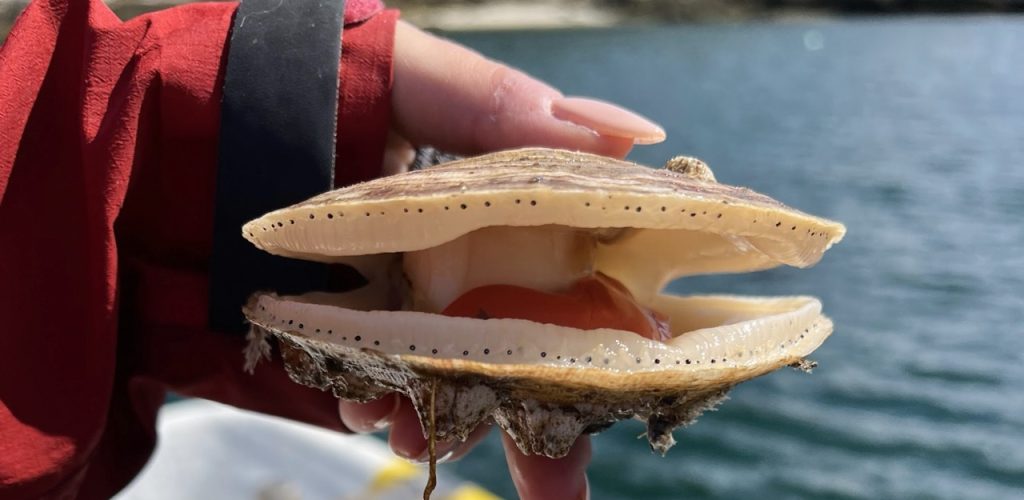
Atlantic sea scallops (Placopecten magellanicus) are a high-value product. In 2024, scallop landings were $8.7 million from the wild and about $152,000 from aquaculture. Growers and researchers in Maine have been exploring how to farm sea scallops for decades. Thanks to methods adopted from colleagues in other countries, practices will continue to evolve with a lot yet to be learned in Maine about their cultivation.
Most scallop farming practices in Maine use gear that hangs from horizontal, underwater longlines, though some producers use cages that sit directly on the seabed.
What Can Be Seen?
When passing a scallop farm it’s likely you will only see a series of buoys marking the location of underwater gear. Unlike some other shellfish aquaculture species, scallops can’t tolerate open air. They need to be completely submerged in water at all times. All aquaculture sites in Maine are required to have their corners marked with yellow buoys that read “SEA FARM” on them.

What Can’t Be Seen?
Every farmer has their own preferred method of farming, and they all look a little bit different. Farms commonly have a 400–800 foot longline that runs horizontally about 10–20 feet under the water. Hanging from the longlines may be different types of nets, or ‘dropper lines’ for the ear-hanging technique. There are a few different production systems in use.

Pearl nets are a series of small, pyramid shaped nets tied vertically to each other and hanging from a longline 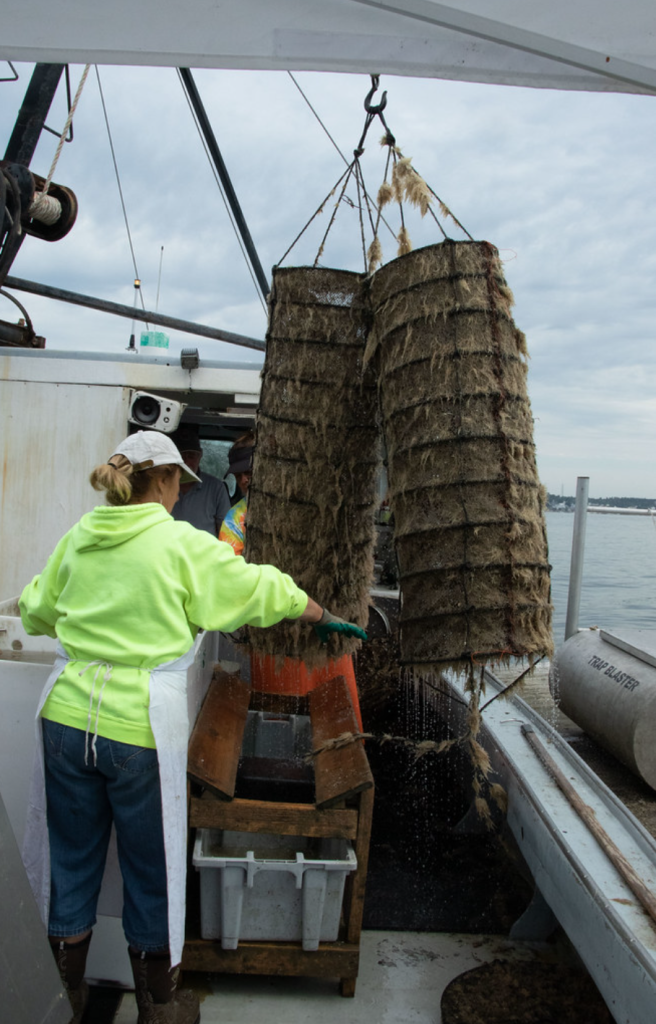
Lantern nets are round, layered, accordion-style nets hanging vertically off the longline 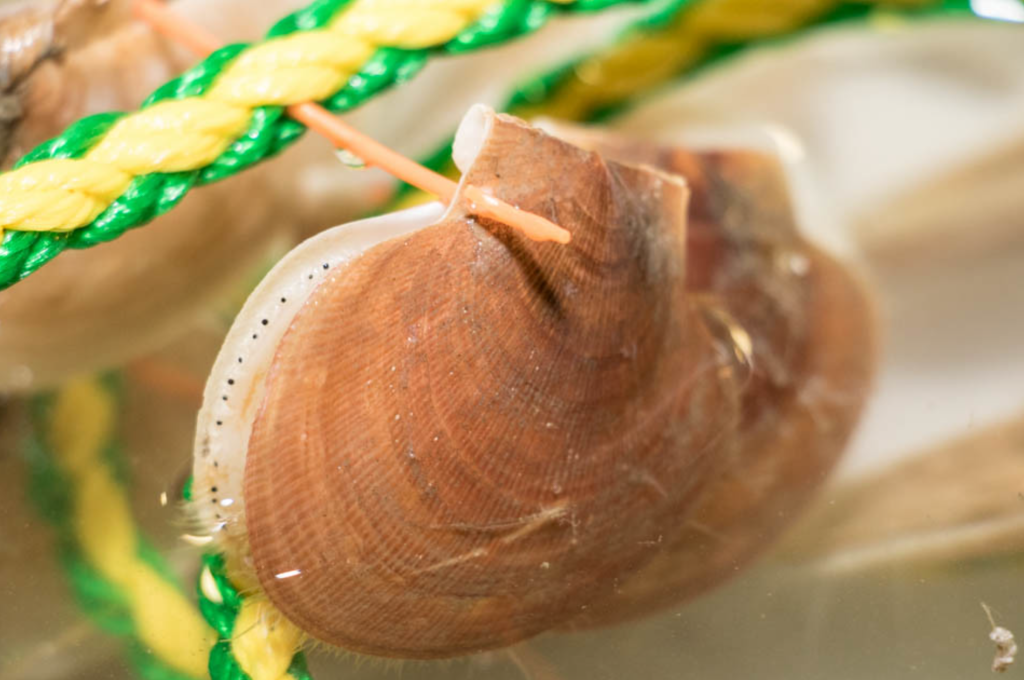
Ear-hung scallops will have a small hole drilled in the top of their shell. A barbed plastic pin is placed through the hole, and the pins are attached to ropes hung vertically in the water 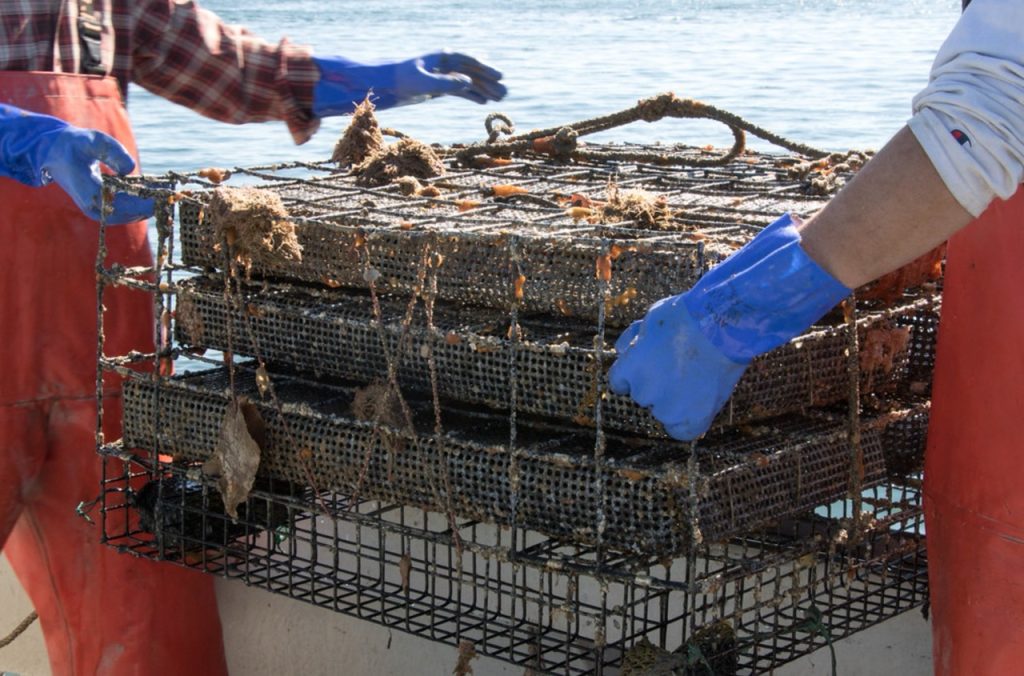
Some farms choose not to use nets at all and opt for cages suspended in the water or sitting on the seabed 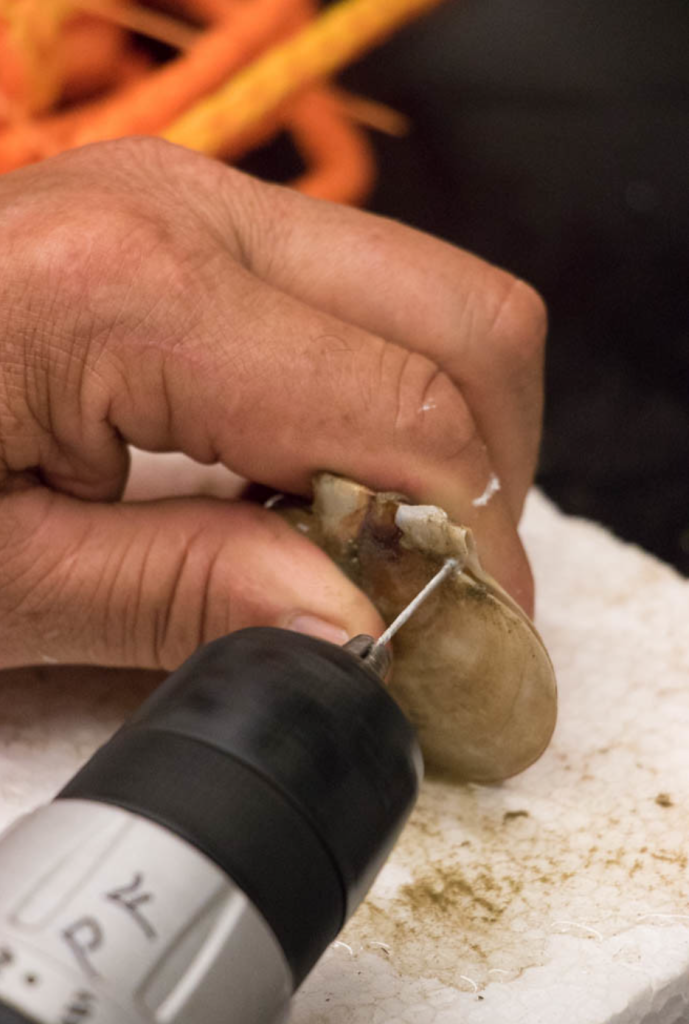
Piercing the “ear” of a scallop
Farming Process
Scallop farming is a lengthy one-to-three year process that has four steps.
Seed Collection
Farmers collect wild larvae starting in the fall. “Spat bags” are deployed in waters were scallop larvae are plentiful; the larvae settle on the substrate inside the bags, and metamorphose into juvenile scallops, also referred to as “seed” or “spat.”
Nursery Rearing
In late spring, farmers transfer the scallops to a nursery. There, the scallops spend eight to twelve months growing in pearl nets, lantern nets, bottom cages, or suspended trays to become large enough to be transferred to growout gear or sold as a product (such as half-shell).
Growout
The scallops grow to market size in pearl nets, lantern nets, cages, or on ear-hanging lines. This usually takes one to three years. Scallops don’t like to be crowded, and will damage each other if piled too close together.
Harvest
Farmers pull the nets or lines from the water, remove the scallops from the gear, and bring the scallops back to shore where they’ll be separated by size, packaged, and brought to market.
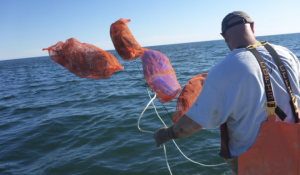
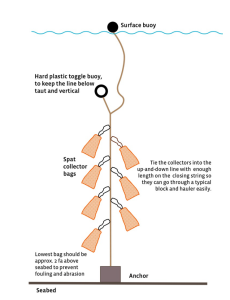
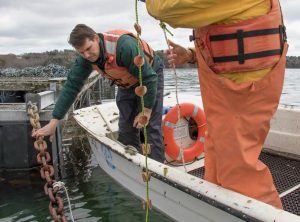
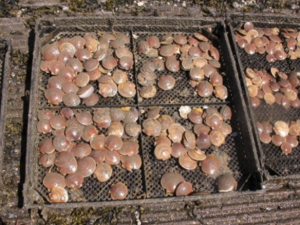
Why Scallop Aquaculture?
Scallop farming requires no land, freshwater, feed, or fertilizer to grow, with minimal environmental impact. In addition, the United States imports an estimated $300 million in scallops annually, so growing them locally has the potential to lower the carbon footprint associated with seafood import.
Frequently Asked Questions about SCALLOPS
Why are Maine waters a good candidate for scallop farming?
Maine waters contain a great amount of nutrients, are in the right temperature zone, and have a diversity of environments along the coast that provide protection for different culturing methods.
How many scallops are on a farm?
The number of scallops per farm varies based on the size of the site and growout method used, but farmed populations can range from hundreds to hundreds of thousands, and as farms grow, over a million animals are possible.
How do scallop farms affect the environment?
Scallops are filter feeders, consuming free-floating phytoplankton or other microorganisms in their surrounding waters, which means farms have the potential to improve the clarity and quality of surrounding waters.
Who owns the scallop farms?
All equipment, gear, and scallops on a farm are privately owned by the farmer. The farmer holds a state-issued lease to use the waters where the farm is located. While the law doesn’t prohibit boaters, kayakers, or swimmers from passing through, it’s important to be respectful of the farmers’ gear.
Are scallops at risk for predation from other species on a farm?
Since the scallops are floating in enclosed gear, they are actually safer on a farm than growing wild. Major predators include crabs and snails, which reside on the seafloor and would have a difficult time climbing up ropes or getting through cages or mesh bags.
Where are scallop farms located?
Scallops prefer waters with temperatures between 50 and 60°F. Since scallops can’t tolerate air or fresh water exposure, you won’t see farms in heads of rivers where you might find other shellfish leases, like oysters.
How large are scallop farms?
Currently, most scallop farms in Maine are only a few acres. As the industry scales up, most functional lease sizes are expected to be in the range of 15-20 acres.
How do storms affect scallop farms?
One of the biggest risks when storms hit farms is the chance of lines breaking loose and/or tangling. Loose lines and tangles can be difficult to unravel, especially with heavy amounts of shellfish inside the gear.
What precautions do boaters need to take around scallop farms?
It is the boater’s responsibility to be aware of navigational hazards, including notifications like corner markers of aquaculture leases. If you are uncertain about navigating in a given area, ask for local information, such as from a Harbormaster, fishermen, or a local sailing club.
More Maine scallop facts…
Atlantic sea scallops (Placopecten magellanicus) are the primary species farmed in Maine, but occasionally, the bay scallop (Aequipecten irradians), is grown as well
In 2021, approximately $85,000 worth of farmed scallops were landed in Maine, and in 2024 that rose to over $152,000
Mussel Farming
Click to download What’s in the Water—Mussel Farming fact sheet
In the wild, blue mussels (Mytilus edulis) are found in tightly packed beds in shallow coastal waters. Harvesting is managed to avoid the possibility of population depletion. To keep up with the commercial demand, farmers are expanding production in Maine’s coastal waters.
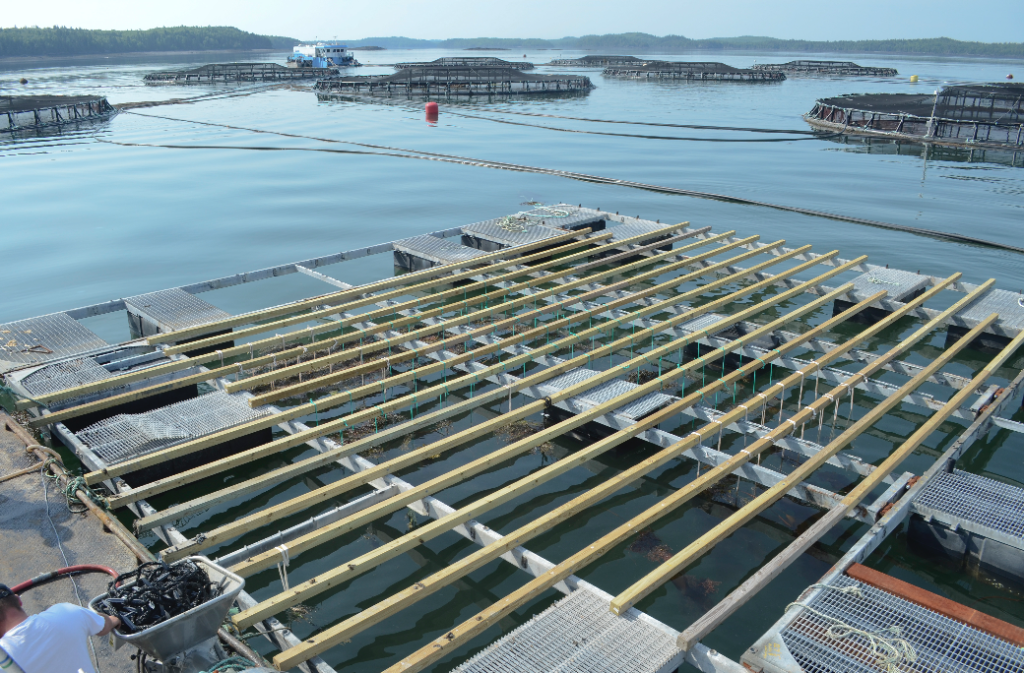
There are two principal methods for farming mussels in Maine: raft culture and bottom culture.
Raft Culture
What Can Be Seen?
Rectangular floats support a steel framework with wooden beams mounted on top. Rafts are usually 40 feet on a side with multiple rafts strung together on a single farm.
What Can’t Be Seen?
Dropper lines are tied around the wooden beams and hang down 40–60 feet in the water below; mussels grow on these lines. Weighted nets line the perimeter of the raft and extend well below the droppers. These nets protect the crop from predation by diving ducks. Rafts are anchored to the seafloor with granite blocks or heavy steel anchors.
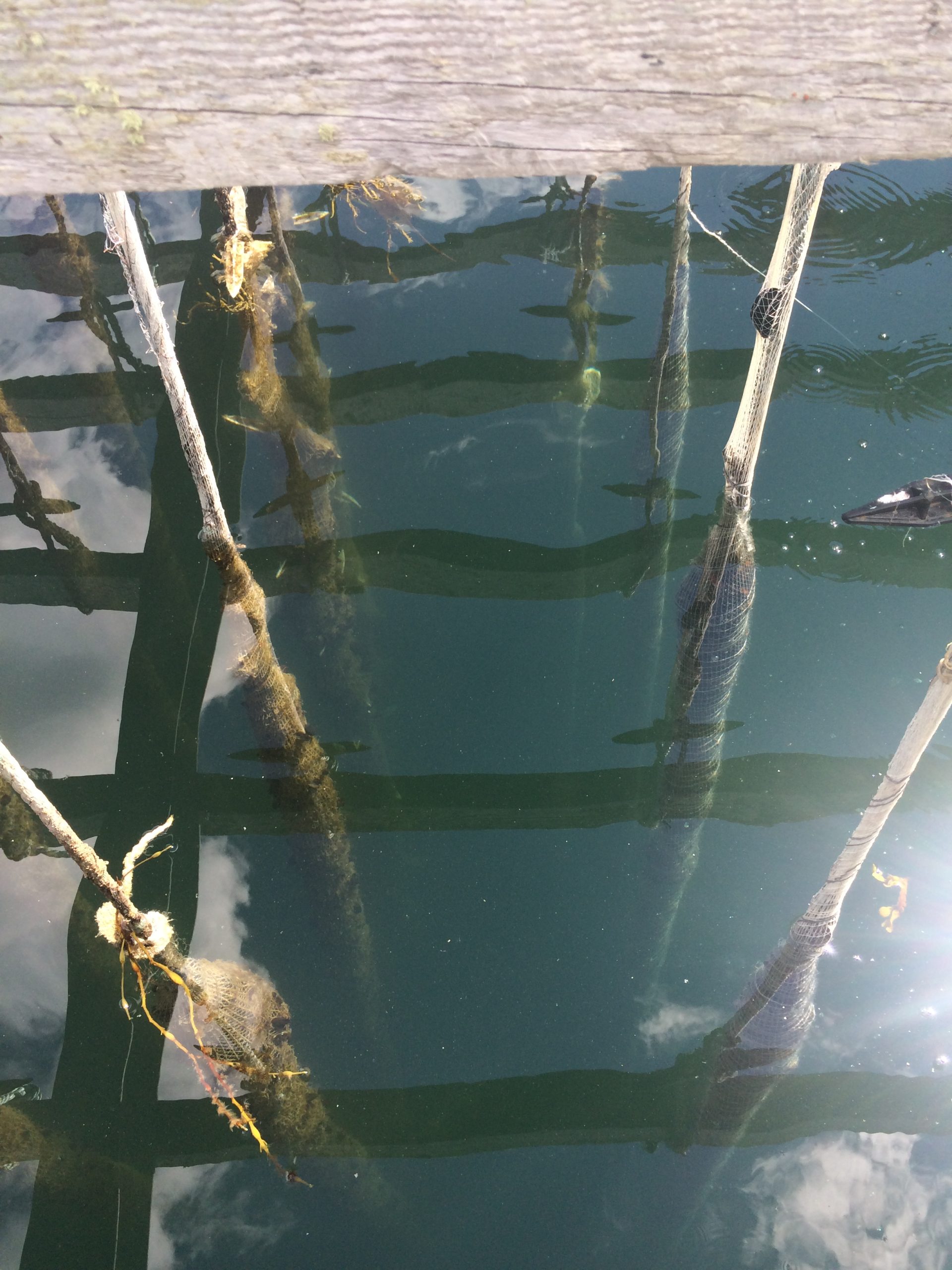
Bottom Culture
Bottom culture has no visible gear above water. However, all aquaculture sites in Maine are required to have their corners marked with bright, large buoys displaying the words “SEA FARM.” Bottom culture farmers distribute small mussels over an area that would mimic a good, natural mussel habitat.

Farming Process
Mussel farming has three stages that can take up to 36 months to cycle through.
Seed Collection
Farmers collect seed from the wild, though some hatchery production exists. The free-floating larvae attach to collection lines and grow there for 6-12 months.
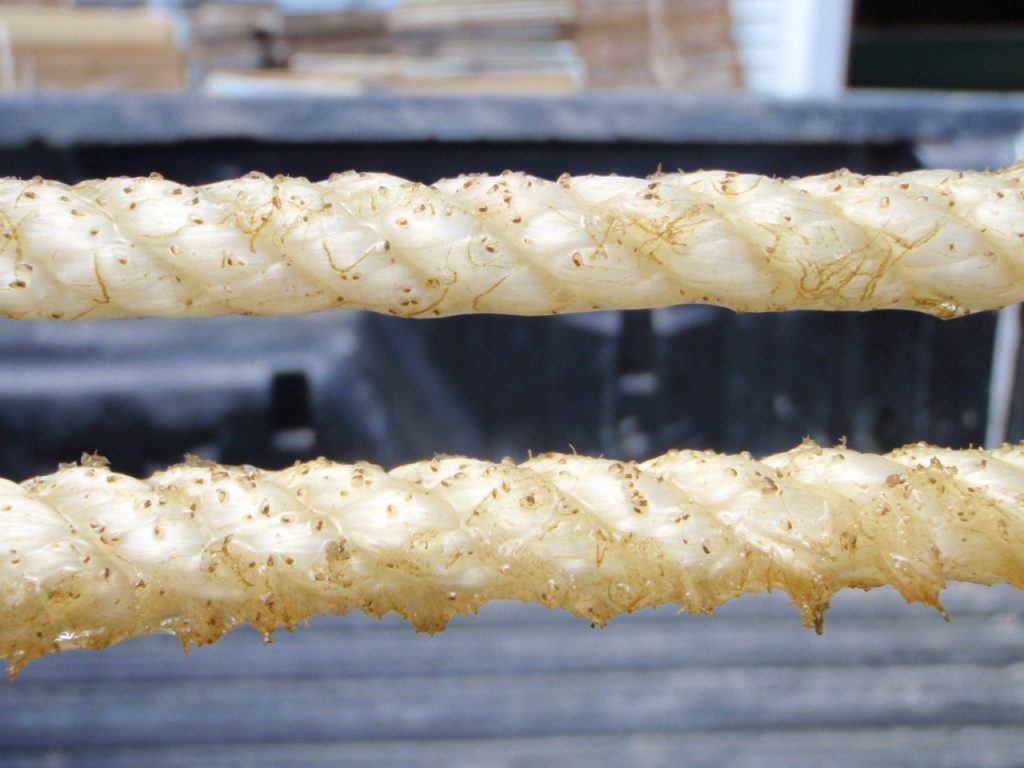
Grow Out
For raft culture, the mussels are transferred from collection lines to dropper lines. For bottom culture, farmers spread the seed over the sea-floor. The mussels grow to market size over two years.
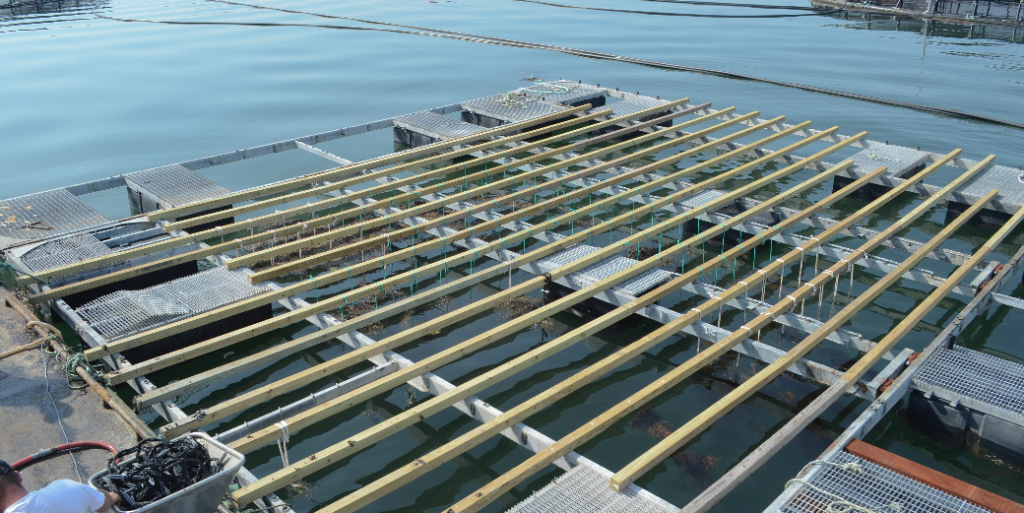
Harvest
Once grown, the mussels will be shaken off from the grow-out lines or harvested from the seafloor by farmers, washed then de-clumped, separated by size, and brought to market.
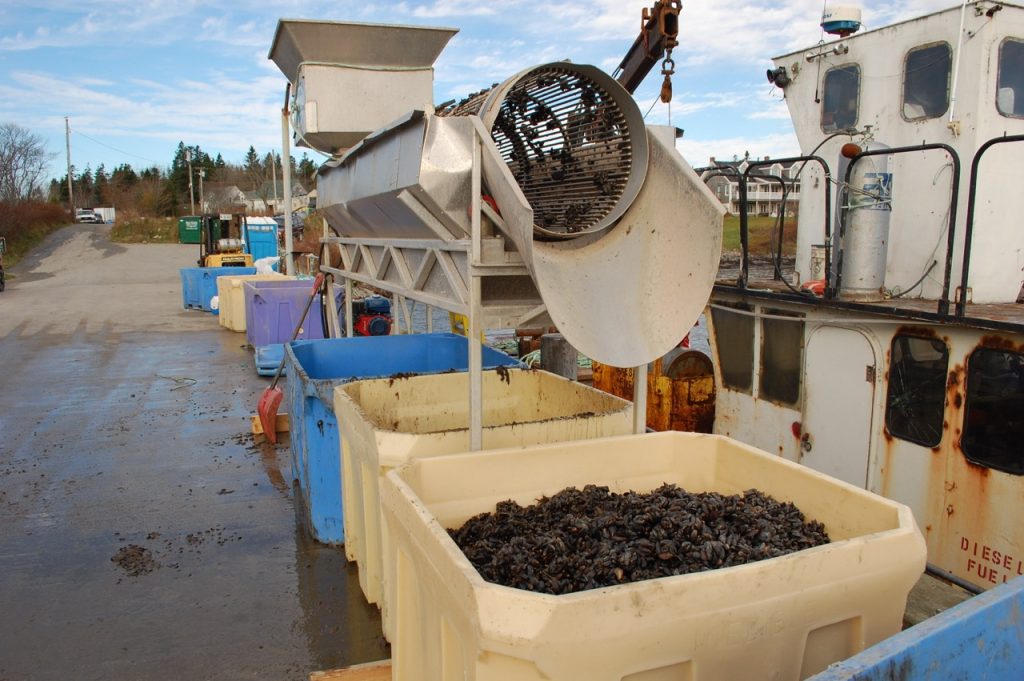
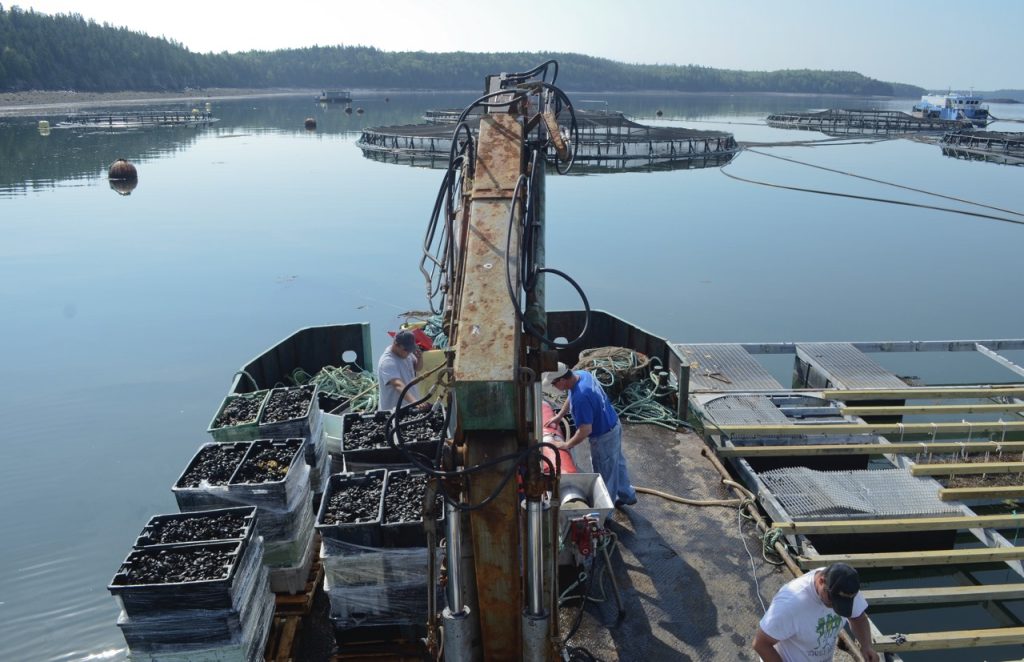
Why Mussel Aquaculture?
Demand for mussels exceeds the ability of natural populations to sustain themselves. Mussel farming is a low-impact, year-round farming process that requires no dry land, fresh water, or feed. Farms can provide job opportunities, diversify working waterfronts, and supply communities with a local and sustainable source
of seafood.
Frequently Asked Questions about MUSSELS
Why are Maine waters a good candidate for mussel farming?
Maine waters contain a great amount of nutrients, are in the right temperature zone, and have a diversity of environments along the coast that can provide protection for raft culture.
How many mussels are on a farm?
The number of mussels depends on the size of the farm. A 40-foot raft might produce 50,000 pounds on a two-year rotation, and a bottom farm might produce 20,000–30,000 pounds per acre on a two to three year rotation.
Where are mussel farms located?
Mussel farms are usually located in fairly protected areas, since heavy waves can cause mussels to drop off the lines, or damage the raft itself. In Maine, rafts can be found in sheltered parts of embankments or up in coastal rivers, where the water is still quite salty but away from storm surge and big waves.
How do mussel farms affect the environment?
Mussels are filter feeders, pulling plankton and bits of organic material out of the water to eat. Mussel farms have the potential to improve the clarity and quality of surrounding waters.
What happens in the winter when the water surface might freeze?
In order to stay afloat with the accumulation of ice and snow, rafts are built with more buoyancy than what is required for the mussels alone. The mussels themselves stay covered with water and are protected, but in extreme cases, farmers need to visit the rafts and break off the ice.
Can I swim over bottom culture farms?
Yes, kayaking, swimming, and boating over bottom farms is allowed, but any equipment or buoys are the private property of the farmer and should be respected and treated as such.
How large are mussel farms?
Bottom culture farms are anywhere between 20 and 40 acres, and raft culture farms are typically between six and ten acres.
How do storms affect mussel farms?
Storms may deposit sand or mud on top of mussels on bottom culture farms. Depending on the storm’s severity, mussel rafts can be damaged. Since rafts are expensive, farmers make sure to choose sites that are protected.
What precautions do boaters need to take around mussel farms?
It is the boater’s responsibility to be aware of navigational hazards. Keep an eye out for buoys of any type, and seek local information if you are unfamiliar with navigation in a given area.
More Maine mussel facts…
The blue mussel (Mytilus edulis), is the native species of Maine and the primary species of mussels that farmers raise on their sites
In 2022, over 8 million pounds of mussels (wild and farmed) were landed in Maine, with an estimated value of over $8.2 million
Oyster Farming
Click to download What’s in the Water—Oyster Farming fact sheet
For thousands of years, harvesting of wild oysters has taken place at various points along the Maine coast, as indicated by the remnants of ancient shell piles (called middens) left by indigenous communities. The current increase in oyster farming has a more recent history, dating to the 1970s when UMaine researcher Dr. Herb Hidu brought hatchery technology to the Darling Marine Center and began a program of research that eventually supported some of Maine’s first oyster farmers. In 2024, roughly 15 farms collectively produced about
17.7 million oysters, with a farm-gate valueof over 14 million dollars.
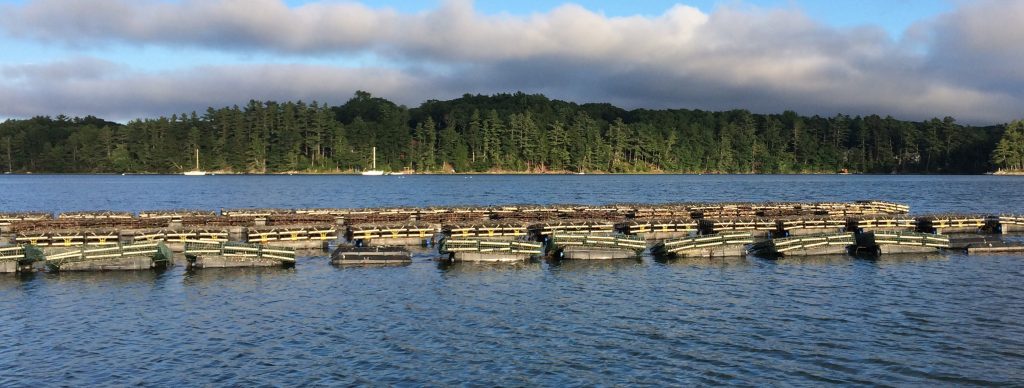
While some farmers grow oysters directly on the seafloor, many oyster farms use gear that floats on the surface. This allows the farmer easy access for grading and harvesting activities, and warmer surface waters provide good growing conditions for oysters. .
Surface Culture
What Can Be Seen?
Oyster Cages
Oyster farmers often use wire mesh cages mounted on two parallel, pontoon-shaped floats. What you see depends on the position of the cage. In the drying position, the individual cages—with the oysters inside them—are completely out of the water and the floats support the cage. In the feeding position, the cage and the oysters are in the water, and you’ll see the floats lined up in pairs in a long row.
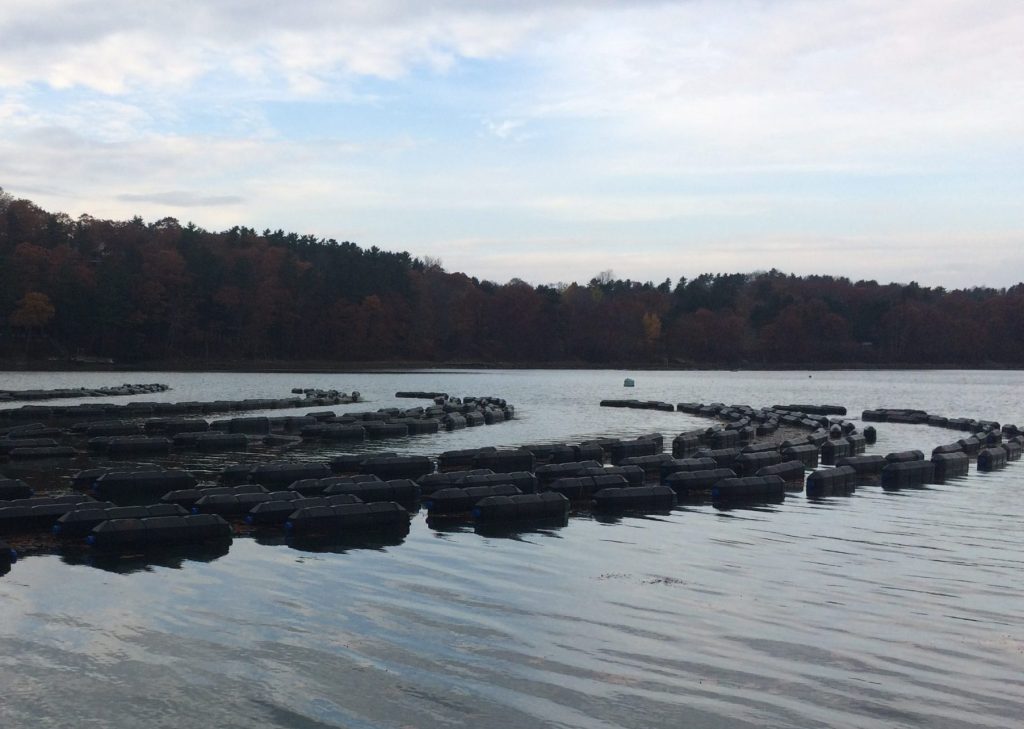
Oyster Bags
Some farmers use individual floating bags to hold the oysters. These black plastic bags are approximately 30″ long by 24″ wide, with two floats attached. These oyster bags will sit half-submerged at the surface so that the oysters are in the water, but the top half of the bag is exposed to air. Often, these bags are arranged in long strings, usually parallel to the current.
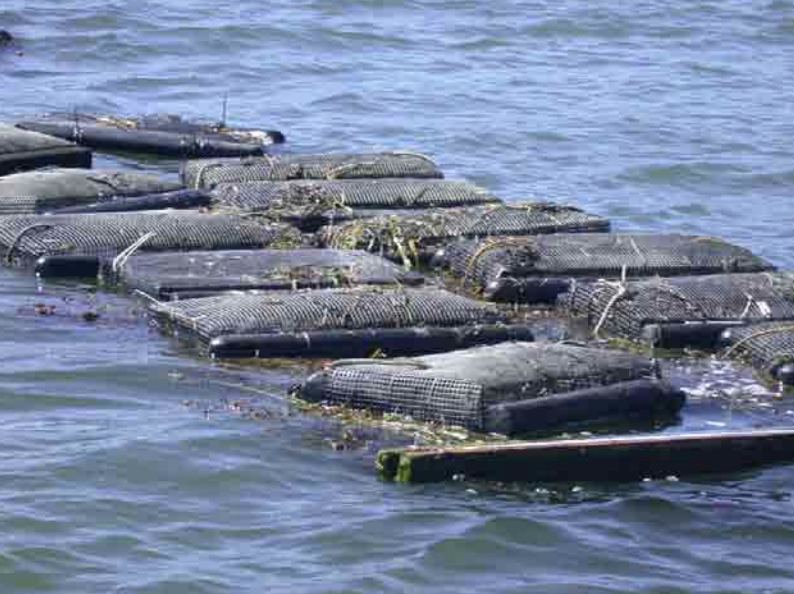
Longline Systems
A few farms use longlines in the intertidal zone or in the shallow subtidal zone; these setups use a series of posts or metal “staples” to support oyster cages. As the tide drops, the oyster cages become visible.
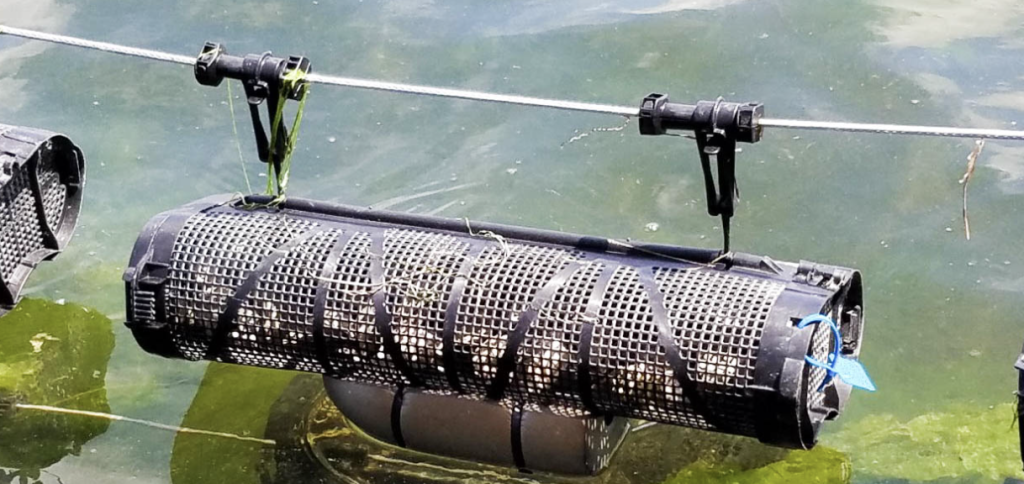
What Can’t Be Seen?
Underwater, ropes connect the cages to one another and to anchors on the bottom of the ocean.
Bottom Culture
What Can Be Seen?
For farms that use the bottom-seeding technique, there is no equipment—oysters are scattered directly over the seabed. However, Maine requires all aquaculture sites to be marked with corner buoys that read “SEA FARM”.

Farming Process
Hatchery
Oyster larvae are raised in indoor, on-shore tanks during the winter months.
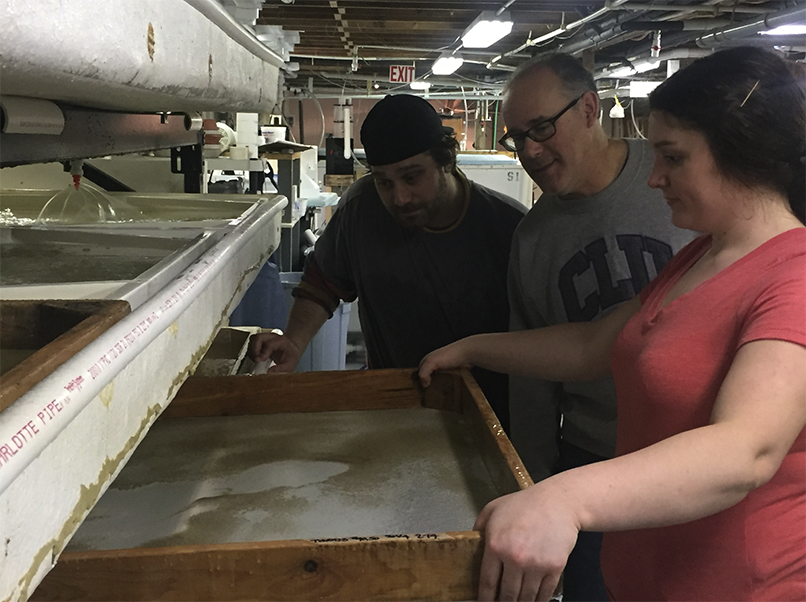
Nursery
Small oysters are placed into seed bags that slide into floating shellfish gear. The oysters will grow to be about seven millimeters in this phase.
Upwellers are increasingly common along the coast. These can take many different forms, but all operate on the principle of directing a flow of seawater up through a bed of small oysters so that each oyster can feed well. Upwellers have several containers called silos. Several silos are usually set into a small raft, and these silos hold the small oysters. A pump is also attached to the raft to move the water up through the silos. An upweller will often be located in a protected area such as a marina, and they look just like a typical float – a casual observer might not know that it’s actually a shellfish farm.
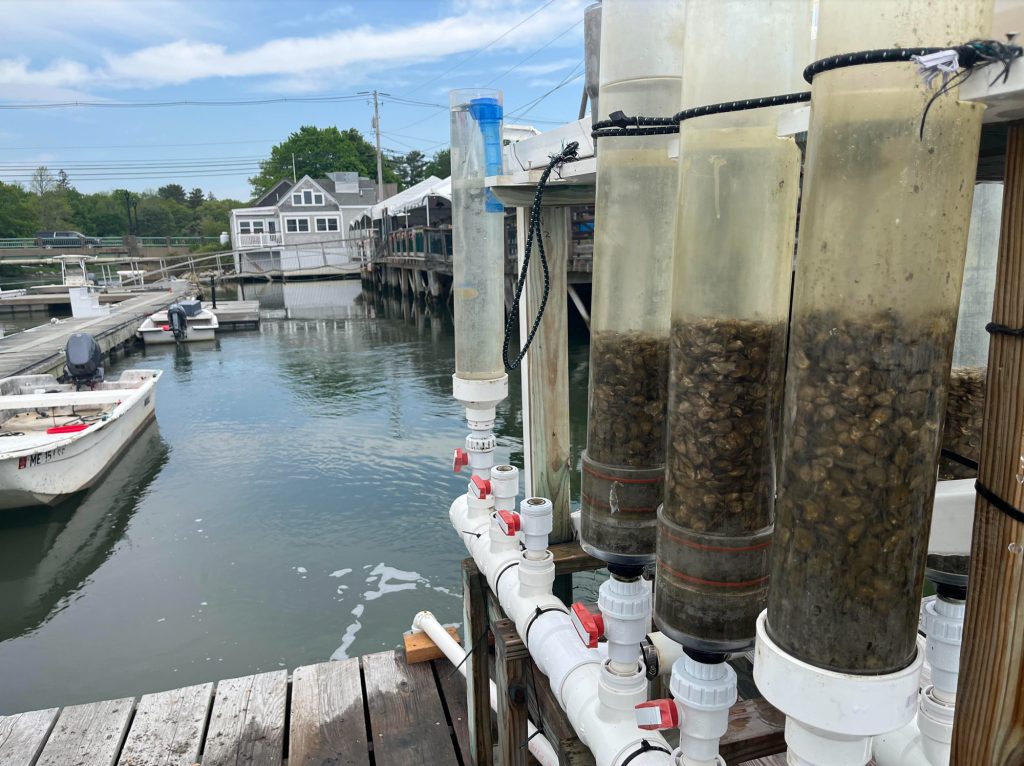
Grow Out
Oysters will spend the next one to three years growing to market size in growout gear. This part of the cycle has several steps:
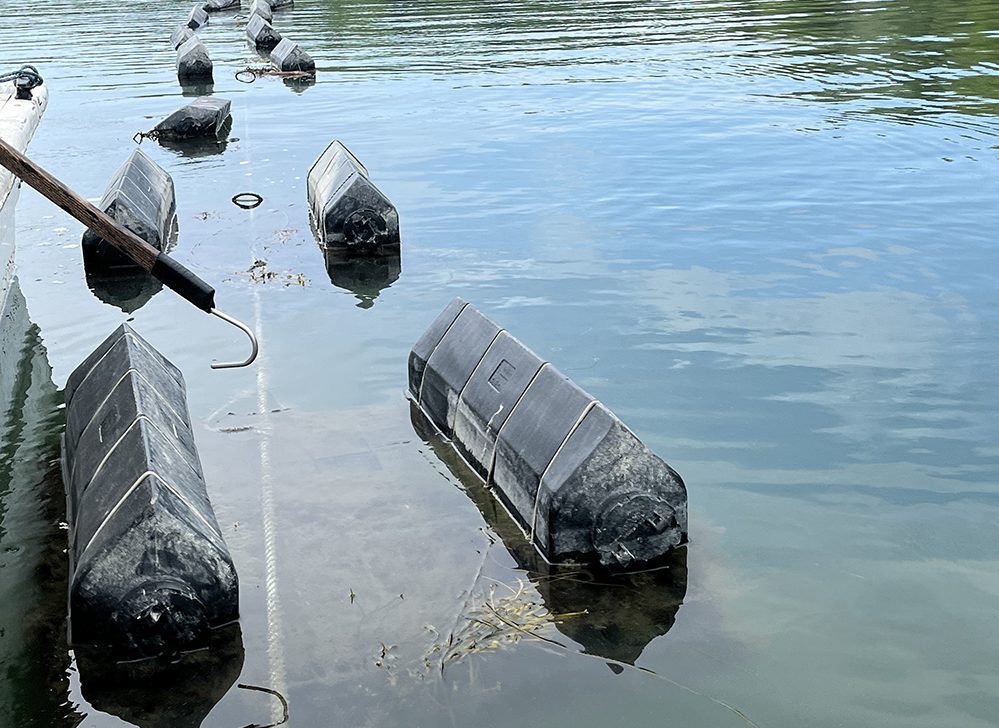
Feeding Position
Oysters cages are flipped down into the water, with the two long floats visible on the surface. This position allows oysters to access water full of the plankton they need to feed and grow.
Drying Position
Every two weeks or so, a farmer will flip the cages so that they rest above the water on top of the two floats. Exposing the caged oysters to sun and air for a day or so eliminates anything that may try to grow on them, such as barnacles, mussels, and other biofouling species. Biofouling is the undesirable buildup of small plants, algae, animals, and other organisms on submerged structures.
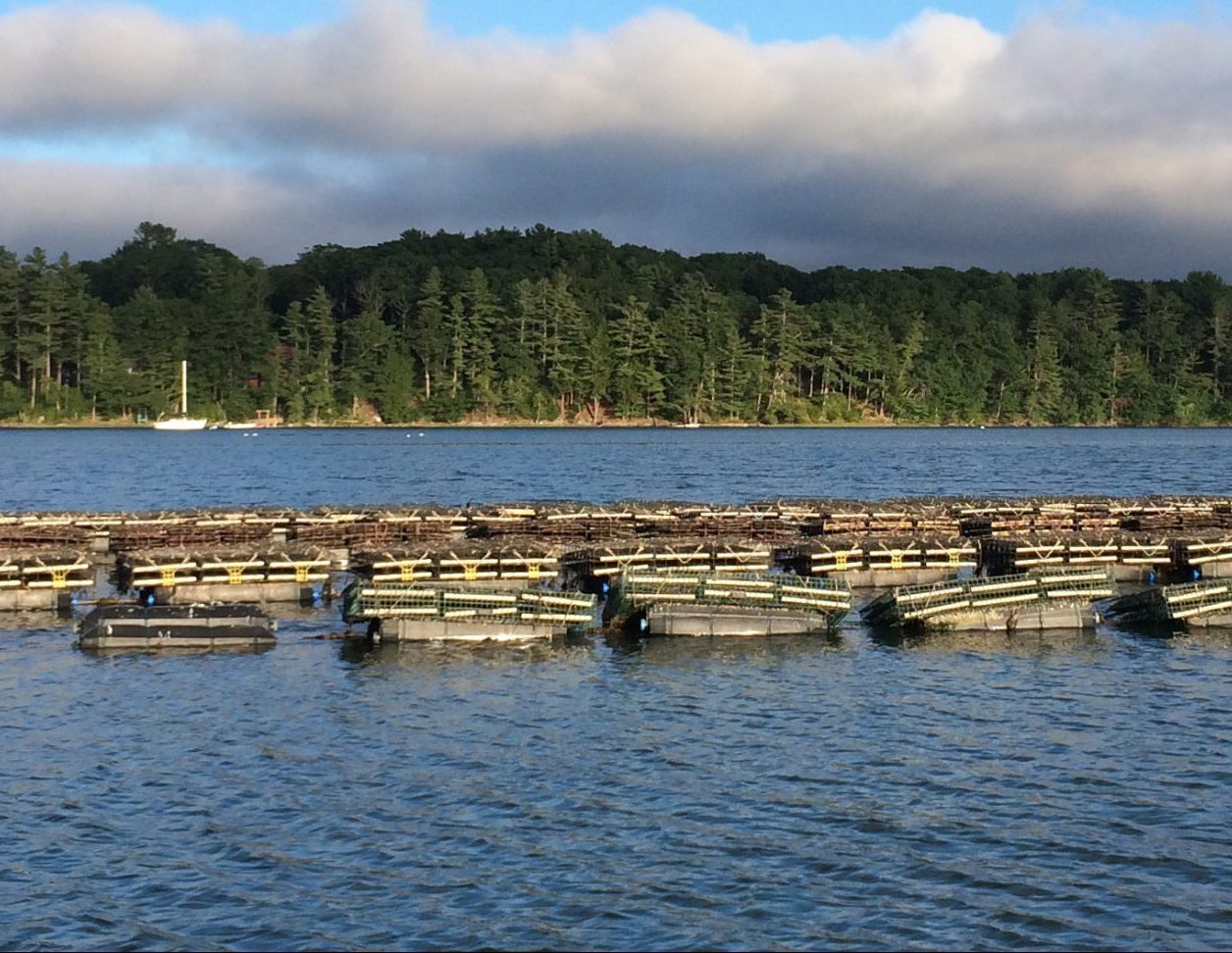
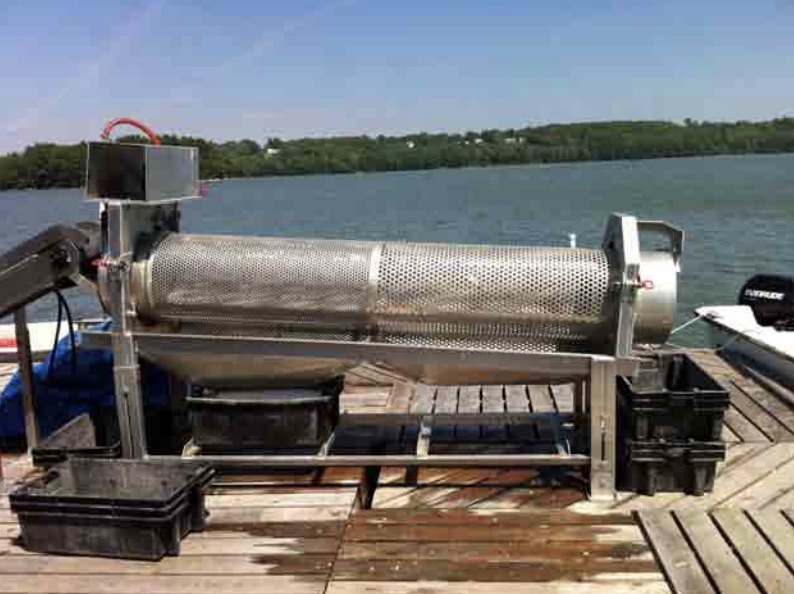
Thinning and Grading
As the oysters grow, they start to crowd each other. Periodically, farmers remove some oysters to keep the mesh bags from overfilling.Those oysters are run through a rotating tube with holes of various sizes, called a grader or a tumbler. As the oysters pass through, they are sorted into small, medium, large, and harvest size.
Harvest
After being graded, market-size oysters are brought to shore for sale.
Frequently Asked Questions about OYSTERS
What do oysters eat?
Oysters are filter feeders. They eat phytoplankton, a little bit of zooplankton, and detritus in the waters around them.
Are oysters at risk for predation from other species on a farm?
Oysters grown right on the seafloor are at risk for predation by creatures like crabs, lobsters, and sea stars. Oysters grown in containers are usually quite well protected and usually do not suffer much loss from predation.
What happens in the winter when the water surface might freeze?
Many farmers “sink the farm” for the winter to protect the crop. This may mean transferring the oysters into cages that sit directly on the bottom, moving the strings of gear to a different location, or sinking the floating cages themselves. Floating/flippable oyster cage floats have caps on the end that can be removed – the floats fill with water and the whole cage can then sit on the bottom for the winter.
Who owns the farms?
All equipment, gear, and oysters on an oyster farm are privately owned by a farmer (an individual or a company). Farmers must hold a state-issued lease or license for the right to use Maine’s coastal waters for aquaculture.
How do oyster farms affect the environment?
An adult oyster can filter up to 50 gallons of water a day, pulling plankton, bacteria, or bits of organic material out of the water to eat. A farm with 100,000 oysters has the potential to filter up to five million gallons of water per day – meaning farms have the potential to improve the clarity and quality of surrounding waters.
Does the location of a farm affect the oysters?
Location has a profound effect on the farm. Wind, waves, current, storms – all of these factors and more are important considerations for growers, as they will affect the shape and look of the oysters. For example: windy, wavy waters can produce smoother and more polished oysters, kind of like rock tumblers.
How large are oyster farms?
Oyster farms can range from under an acre to more than 30 acres. In Maine, the average oyster farm is about seven acres.
How do storms affect oyster farms?
The biggest storm risk for oyster farmers is equipment failure: a rope breaking, an anchor releasing, or a shackle letting go. Farmers work hard to limit or eliminate the loss of gear, and to build and maintain robust farming equipment.
What precautions do boaters need to take around oyster farms?
Aquaculture farms are required by law to have marked buoys at the corners of each farm. It is the boater’s responsibility to be aware of navigational hazards like ropes and cages inside of the farm site.
More Maine oyster facts…
The American or Eastern Oyster, (Crassostrea virginica) is native to Maine, but ranges along the East Coast of North America from the Gulf of St. Lawrence to the Gulf of America
In 2024, Maine’s commercial oyster landings valued over $10 million for over 14 million oysters brought to market
Net-pen Salmon Farming
Maine farmers began to cultivate domestic populations of Atlantic salmon in the 1980s utilizing net pen farming practices, providing high-quality fish to consumers.
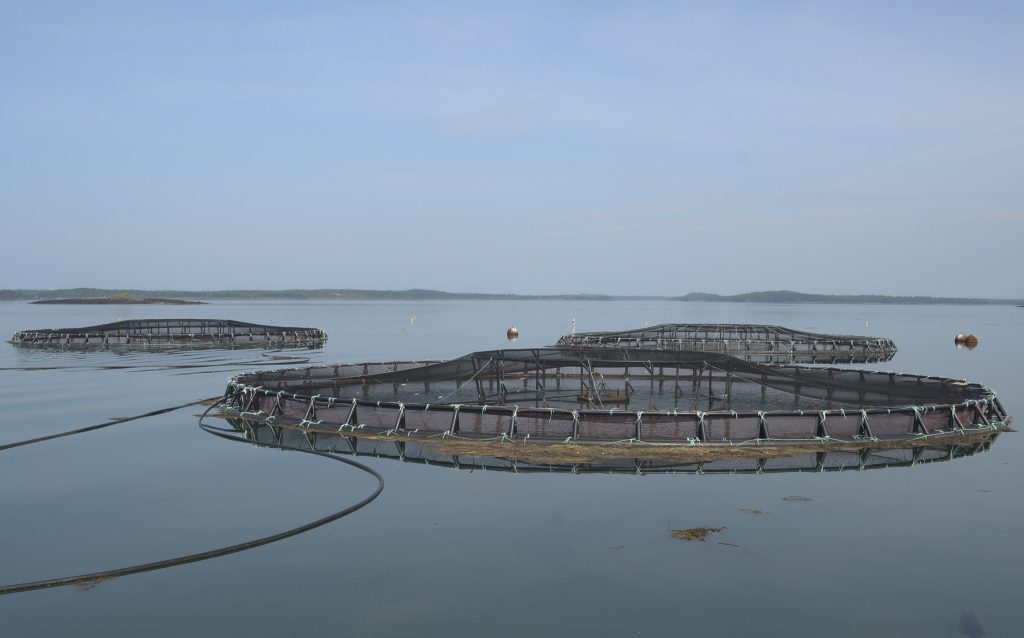
What Can Be Seen?
When looking at a salmon farm, you’ll be able to see large, circular, floating net-pens in open bodies of salt water. These floating pens are covered with netting to keep birds from accessing the fish. You may see other floating structures near the pens, such as boats that are equipped for feeding, harvesting, and net-washing. In addition to the farm itself, Maine requires all aquaculture sites to be marked with bright, large, corner buoys that say “Sea Farm”.
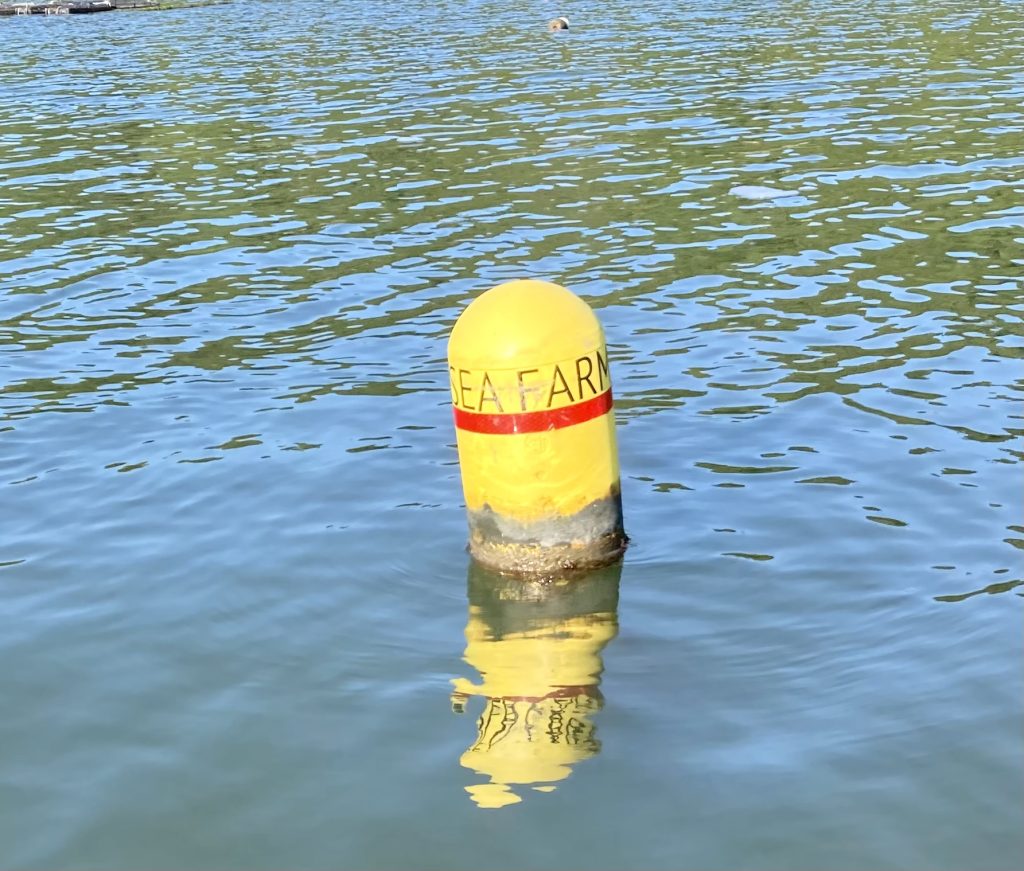

What Can’t Be Seen?
Containment nets extend 30 to 50 feet below the surface, and are attached to the floating pens. The net mesh size is small enough to prevent fish from escaping but large enough to allow water flow. A secondary is net layered around the primary net, which works to prevent predators such as seals and cormorants from getting near the fish. In most cases, a series of net pens are held in place by a checkerboard grid of strong lines and multiple anchors that provide stability.
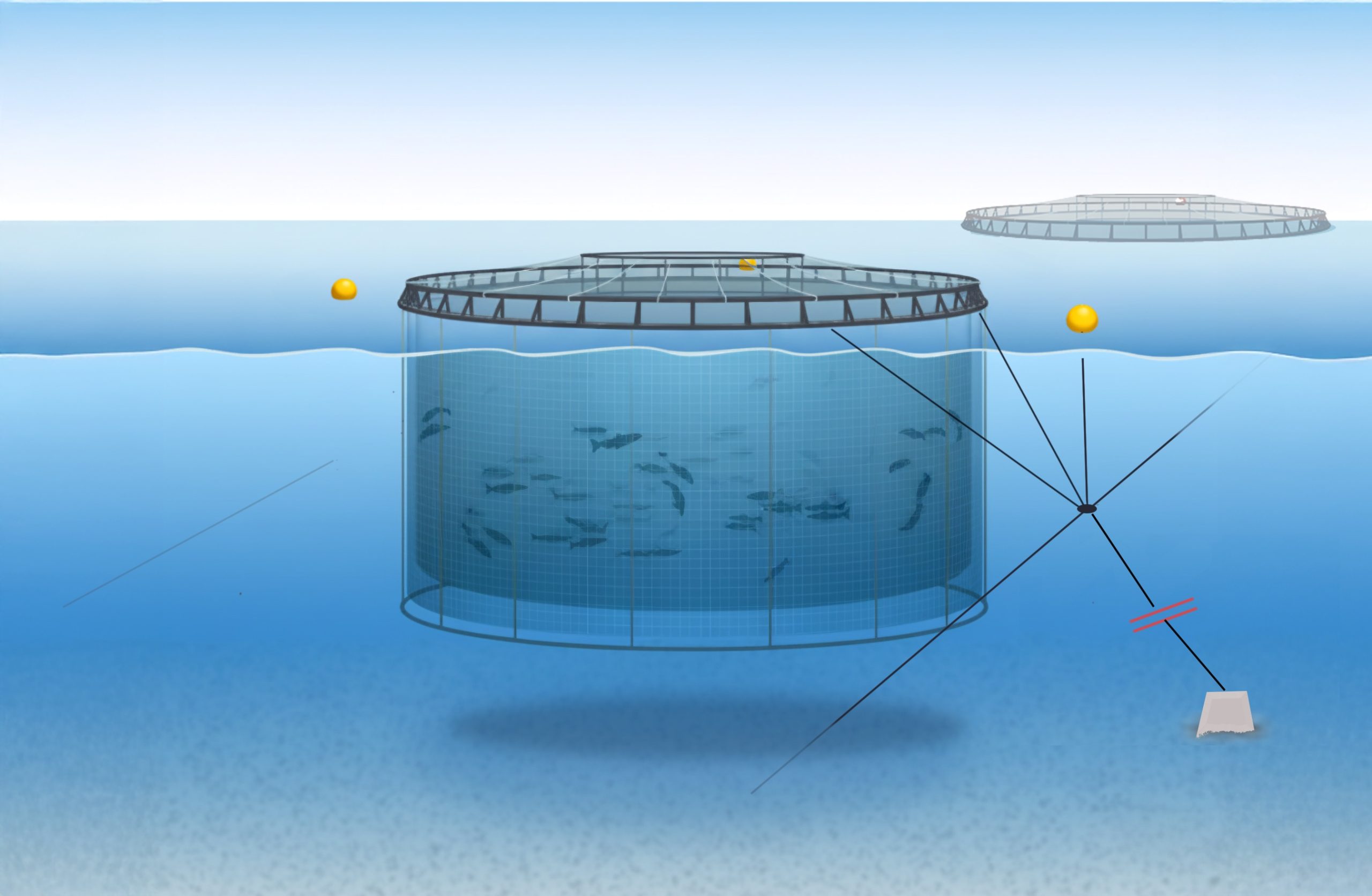
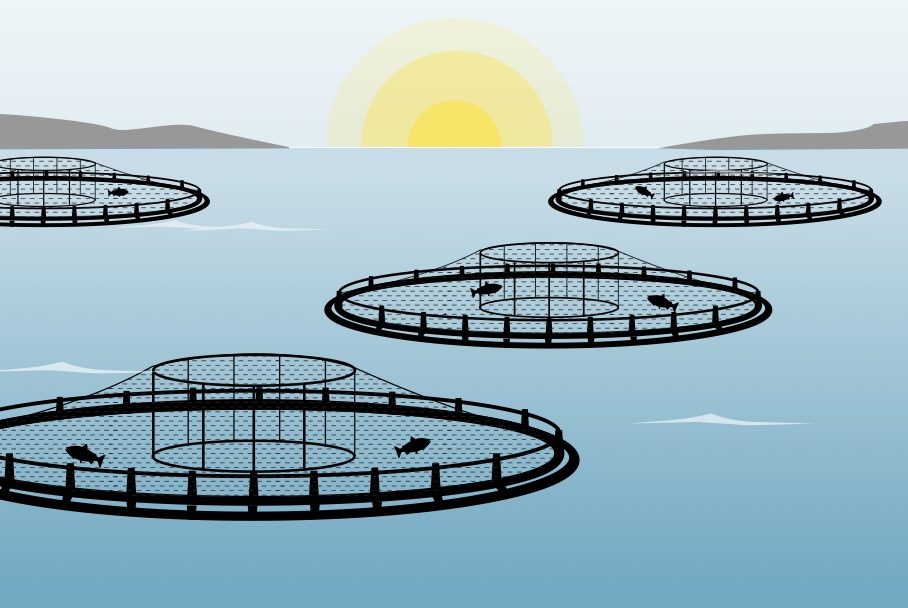
Farming Process
Atlantic Salmon are sea-run fish: they spend part of their life in fresh water and another part in salt water. Because of this, farmers raise salmon in on-shore freshwater hatcheries before transporting them to the marine net pens.
Freshwater Hatcheries
The salmon spend 18 months in a freshwater, land-based hatchery. Here they grow from fertilized eggs to small fish, roughly six to eight inches long. Farmers carefully transport the salmon to saltwater farms during late April or early May when the salt water gets to around 50° Fahrenheit.
Marine Net Pens
The salmon stay in the saltwater environment for another 18–24 months with routine feeding, monitoring, and sampling by farmers. During this time they grow from three to five ounces to eight to twelve pounds.
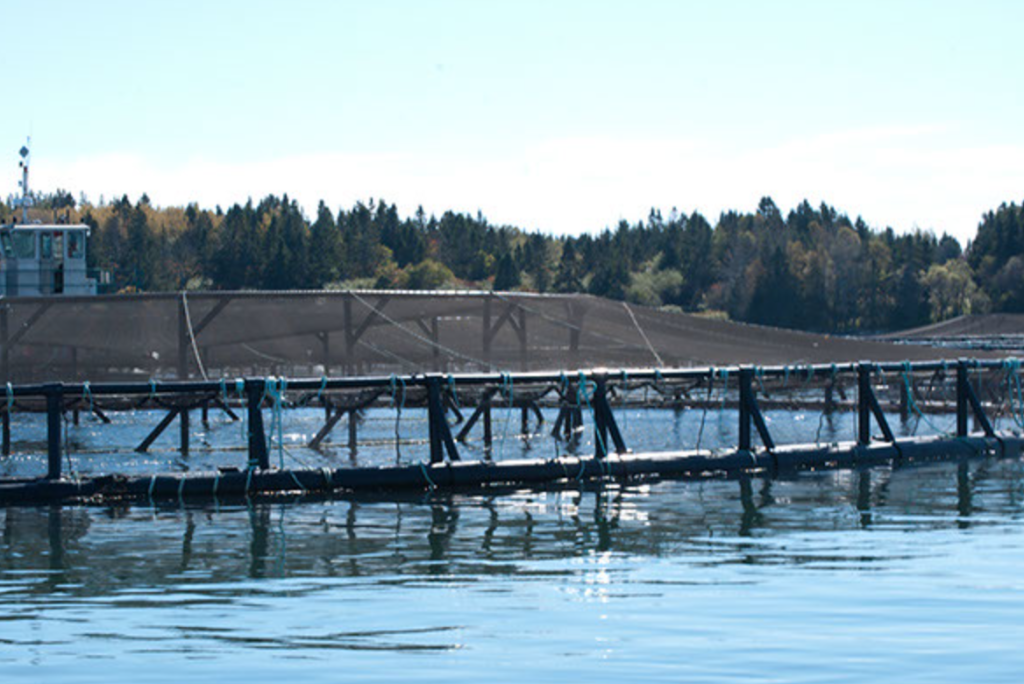
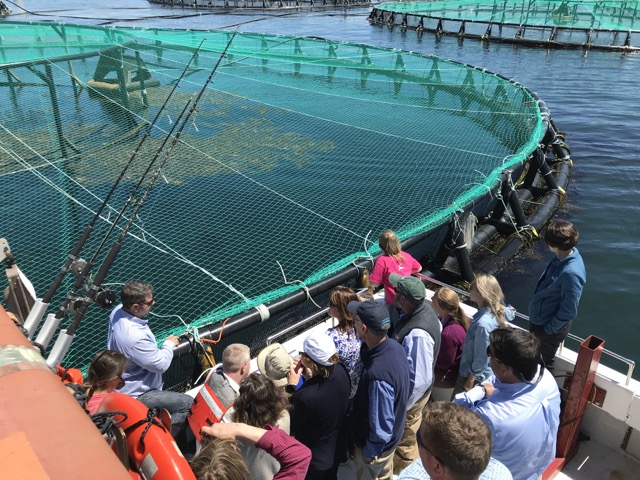
Harvest
When the salmon reach marketable size, the fish are harvested, cleaned, iced, and shipped to customers.
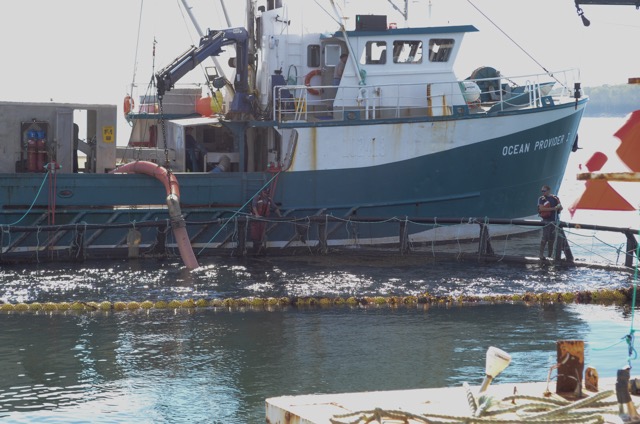
Why Net-pen Aquaculture?
Due to consumer demand, the United States imports salmon from other countries like Chile, Norway, and Canada. The utilization of net-pen farms can reduce carbon emissions from import, while supporting a healthy and sustainable aquaculture practice.
Frequently Asked Questions about Net-pen Farming
What do the salmon eat?
Net pen salmon are fed nutrient-dense dry pellets made of fish meal, plant proteins, vitamins, and minerals.
How many times a day do the salmon eat?
For the first month or so, young salmon can be fed up to 12 times a day. The transition from fresh to salt water suppresses their appetite, so they’re fed more frequently to try to get them back into eating. Once they are comfortable in their new saltwater environment, they are fed on average two times a day.
How many net-pen farms are in Maine?
There are between 25 and 30 salmon aquaculture leases in Maine. While this is the number of lease sites, not all are active. There are typically up to ten farms raising fish at any one time.
How many fish are in a pen?
It all depends on the size of the nets and the depth of the water. In Cobscook Bay, where the first commercial salmon farms were located, the average is 25,000 fish per pen.
Do other fish species ever get into the net pens?
Herring, harbor pollock, and lumpfish are common inside pens in small numbers.
How do net pen farms affect surrounding ecosystems?
Proper feeding practices minimize feed waste under the pens. There’s a chance of migration by species that like cool, shaded, nutritious environments provided under the pens such as capatella worms, which are food to other nutritious fish like flounder. Likewise, certain species might attach to the net pens, like blue mussels, which are filter-feeding shellfish.
How far offshore are farms required to be?
While there’s no specific requirement as to how far offshore farms need to be, certain factors are taken into consideration when reviewing an application for a lease. These include preexisting commercial fishing practices in the area, whether the site location will create an impediment to existing navigation channels, or whether a farmer would have to cross someone else’s property to access their farm. The last example is less likely with salmon farms since they’re located in subtidal waters rather than intertidal zones.
What precautionary measures do I need to take as a boater?
As a boater it’s important to be aware of navigational hazards like ropes that can’t be seen on the water’s surface. Be sure to keep an eye out for buoys to avoid entangling propellers with underwater gear. While kayaking, swimming, and boating near farms is not prohibited, they are private facilities and should be respected and treated as such.
How do storms affect fish and farms?
Pens are built to be flexible and strong in order to withstand wind, waves, and storms. When choosing a site, prospective farmers look for an area that has cold, oxygen-rich water and tidal flow with enough depth, located near a shore to provide some protection of offshore high energy storms.
RAS (Recirculating Aquaculture Systems) Salmon
Recirculating aquaculture systems (RAS) are a farming method that allows ocean farming to move out of the water and onto the land. Though they are more common in non-coastal states, a few companies and communities are beginning
to explore the possibility in Maine.

What Can I See?
From the outside, RAS facilities look like large buildings. Depending on the size of the facility, there may be just one building or a series of buildings on the same property. Facilities are located close to a municipal or underground water source and are typically multiple acres of land.
When looking at a salmon farm, you’ll be able to see large, circular, floating cages in open bodies of saltwater. These floating cages are covered with netting to reduce bird predation. You may see other floating structures near the pens – farmers anchor their boats that are equipped for feeding, harvesting, and netwashing to the pens. In addition to the farm itself, Maine requires all aquaculture sites to be marked with bright, large, corner buoys that say “Sea Farm”.


What Would I See?
If you were to take a tour through a RAS facility, you’d see a wide size range of tanks that hold salmon throughout different stages of their lifecycle. Eggs begin in incubators, which look like stackable trays, before being moved to small tanks that are aligned into rows. As the fish continue to grow, they are moved into larger tanks that require a netted cover to prevent fish from accidentally jumping out. All of the tanks in the facility are connected to pumps that filter and recirculate the water inside. In addition to the fish-filled tanks, there are many other important pieces of equipment necessary to ensure the proper care of the salmon, such as oxygen generators, disinfection systems, and temperature regulators, though each facility will be set up differently.

Farming Process
Raising salmon using RAS technologies is a unique process that must be carefully monitored and controlled.
Hatchery
Salmon in the RAS facilities begin as fertilized eggs that spend six to eight weeks in the nursery. Once hatched, the young salmon are transferred to bigger tanks.
Grow Out
The salmon will mature into adults during their one to two years in grow-out tanks, where they’ll have plenty of space to swim, school, and grow naturally. RAS technicians will regularly monitor, sample, and feed the fish during this stage.
Harvest
Graders are dropped into the tanks to separate the larger fish from the smaller ones—smaller fish are able to swim through the holes to get back to the open area of the tanks. The fish that are too large to pass through the grader will be chosen for harvest and removed to be sent to processors.
Why RAS Aquaculture?
RAS technology uses specialized equipment to raise aquatic species in highly controlled, land-based buildings. RASs are designed to reduce water use, and protect fish from pathogens, predators, and escape. This method also allows for local fish production, which lowers transportation costs and carbon footprints, while collecting and composting fish waste to reduce pollution. The technology precisely controls environmental factors like temperature, water quality, and feeds to create an ideal environment for fish to grow.
Do US farm-raised salmon contain growth hormones and artificial additives?
In the US, the Food and Drug Administration (FDA) has prohibited using growth hormones in food fish aquaculture. For the very few drugs approved by the FDA for use with aquatic animals, strict withdrawal schedules are followed so that residues do not remain when fish reach the market.
Where does the waste from the tanks go?
Any uneaten fish food and all fish waste is collected, composted, and used as a soil fertilizer by local farmers, or turned into biogas or biofuels to help power the RAS facilities.
How can RAS help my community?
RAS technology can be used in places that are landlocked, providing food security, job growth, and support of local economies.
How can RAS help our environment?
Almost 90% of seafood in the United States is imported from countries like Canada, Chile, and Norway. RAS technologies will increase the domestic seafood availability and therefore minimize the carbon footprint left behind by the importation of seafood.
What are the benefits of land-based farming?
RAS are a critical advance in salmon farming because they eliminate risks like waste pollution, fish escapes, and fish pathogens.
Are any other species raised in RAS facilities?
Trout, arctic char, sturgeon, shrimp, and eels are also being raised in RAS facilities around the world.
seagrant.umaine.edu | 207.581.1435
The Maine Sea Grant College Program at the University of Maine, sponsored by the National Oceanic and Atmospheric Administration (NOAA) and the State of Maine, is a part of a network of 34 NOAA Sea Grant Programs throughout the coastal and Great Lakes states and territories.
The University of Maine System is an equal opportunity institution committed to nondiscrimination.

